-
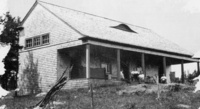 Bear Hill Golf Club, circa 1900
Bear Hill Golf Club, circa 1900 "According to the history published for the Wakefield Tercentenary observance, residents in the newly established Park Section of Wakefield organized a country club soon after the area was developed by Stendman Hanks. Headquartered on Morrison Road, the Bear Hill Golf Club moved to its first home on Hopkins Street in 1900, where a club house was built and a nine-hole golf course laid out. The Club purchased additional land in 1913, and, to meet the needs of the increasing membership, erected a new club house in 1920 on the south side of Prospect Street. A new nine-hole golf course was laid out. Several additional purchases of adjacent land over the years resulted in the lengthening of the golf holes. The second club house was destroyed by fire in 1939, and members rebuilt the clubhouse on the same site, using the existing foundation." -- Text from calendar by Jayne M. D'Onofrio.
-
 Bayrd's Indian Trading Post, Main Street, circa 1985
Bayrd's Indian Trading Post, Main Street, circa 1985 "Bayrd's Indian Trading Post on Main Street, opposite Lake Quannapowitt, was a Wakefield landmark from the time it was built in 1954 until it was razed on August 17, 1995. Designed, owned and occupied by E. Leonard (Lenny) Bayrd, a half Narragansett Native American also known as Chief Wamblesakee (Eagle Claw), the building was a home as well as a craftshop where Lenny and Ruth Bayrd made authentic Native American artifacts and costumes. When the Bayrds purchased the brush-filled property at the head of Lake Quannpowitt in the early 1950s, it was occupied by a teahouse. After Lenny retired from a 27-year career as a letter carrier in December 1954, the couple turned a hobby into a full-time career when they moved into the new house attached to the twin-teepee flanked shop. His 'elaborate beaded costumes and gaily-colored feather bonnets' were featured in a national magazine in 1954. For more than 35 years, the shop was frequented by other Native Americans, fellow members of the Order of Red Men, members of the Wahpatuck Tribe of Red Men's Band, and local residents. Bayrd also made the headdresses and costumes worn by the Wakefield high School Majorettes for many years as well as costumes and headdresses worn by by Saugus High School cheerleaders, Western movie stars, rodeo performers and Buffy Sainte-Marie, a well known singer and former Wakefield resident. Although as a Native American, Lenny was able to obtain eagle feathers from the Department of Fish and Game that he used in his headdresses and costumes, the eagle-feathered items could only be sold to other Native Americans or passed down to family members. In addition to the couple's handiwork that was known throughout the country and Europe, the shop contained displays of many artifacts that had been found in Wakefield. Among those artifacts were plummets found in Lake Quannpowitt once used to weigh down fishing nets, arrowheads and a grommet (a stone with two holes which was worn around the neck which identified the wearer as a messenger not to be harmed) found on Parker Road. Following Lenny Bayrd's death in 1990 and Ruth Bayrd's death in 1991 the property was sold to the Gingerbread Construction Company in 1995.' " -- Text from calendar by Jayne M. D'Onofrio.
-
 Bay State Military Rifle Association, circa 1906
Bay State Military Rifle Association, circa 1906 "'Systematic instruction' in military rifle shooting was deemed essential by the government in 1875. As a result, the Massachusetts Volunteer Rifle Association was created and the first military rifle competition in the state was held in the South Framingham Campground. The Richardson Light Guard rifle team was organized in July 1878 and went on to take first place in the Regimental Matches from 1890 to 1907, as well as in many other significant matches. Company A's first permanent range was located in the rear of the Wakefield Rattan Company, with an established range of 200 yards. The local Militia was issued Model 45/70 Springfield breech loading rifles. State qualification requirements called for shooting at greater distance, and as a result, the local company moved to the Massachusetts Rifle Association range at Walnut Hill in Woburn. In 1891, the Selectmen vote to permit firing at the required 500 and 600-yard distances enabling the company to return to Wakefield. This was short-lived as the area became more densely populated. The Cox Woods, at the corner of Haverhill and Pine Streets (now Bay State Road), was selected by the company as the site of its new range and it was soon equipped with a shooting house and 200, 500 and 600-yard ranges. The Wakefield range became home to the Massachusetts State Rifle Team after it left Walnut Hill. The range so impressed the Inspector general of the Rifle Practice that a canvas of top military men was taken, and the Bay State Military Rifle Association was established. The association paid the town $200 each year for the remaining two years of the Town's lease and allowed the local rifle company to use its facilities. The facility was used as a rifle range for the US Navy during World War I. The Commonwealth of Massachusetts took over the range in 1925 and the name was changed to Camp Curtis Guild to honor Massachusetts Governor Curtis Guild, Jr. During World War II, extensive changes were made and the camp was used for military training and as a mobilization and overseas evacuation point." -- Text from calendar by Jayne M. D'Onofrio.
-
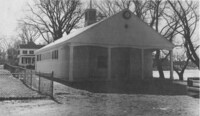 Bath house, Lake Quannpowitt, 1940
Bath house, Lake Quannpowitt, 1940 "During the 1930's and 1940's many varied public works and construction projects were completed by the WPA (Works Progress Administration) within the Town of Wakefield. These projects ranged from the typing of Town records in 1934, to the remodeling of the Lafayette School into municipal offices and veterans' office quarters in 1937, to the construction of eight newly accepted streets and several sidewalks in 1937. In 1939, Wakefield Selectmen voted to ask the Special Town Meeting to build a bath house on Spaulding Street at Lake Quannapowitt, as well as other recreation projects, using ther skills of WPA workers at an estimated cost of $2,000. Just one week later, the estimated cost rose to $5,500 a fact that created debate within the community. The WPA Supervisor was asked to submit other plans which were not so elaborate which would 'entail a smaller expenditure to the Town and yet produce a satisfactory bath house,' the Selectmen feeling that the proposed bath house could not be erected for that amount of money. New plans were submitted by the Wakefield Rotary Club's community service committee which reduced the proposed costs from $5,500 to between $3,500 and $3,000. The building would not be made of brick as in the previous plans and would not be heated for winter use. The bath house could accommodate 100 boys and 100 girls and would be a modern building with asphalt shingles. On March 23, 1939, Special Town Meeting voted to build the bath house at a cost of $5,261 by a close vote. The Spaulding Street bath house was completed in 1940 for a cost of $6,882.59. The bath house was removed in 1994 to the Forest Glade Cemetery." -- Text from calendar by Jayne M. D'Onofrio.
-
 Baseball, 1945
Baseball, 1945 "As one of the oldest, if not the oldest, sport at Wakefield High School, boys baseball was originally played on the Common. In 1900, the WHS baseball team won the state title by defeating Lawrence 18-8. Many of the members of the 1945 WHS baseball team, the first to be coached by Coach James Walsh, returned to the diamond the following year. While the 1945 team had five wins in 11 starts, the 1946 baseball team, captured the Middlesex League crown with a 14-3 record in its first year of play in the league. The team went on to play in the state competition at Fenway Park, beating Lawrence in the first game, and losing to Newton by a score of 4-2. During the season, pitcher Les DeMarco pitched two nine inning no-hitters. In 1954, the WHS baseball team made the record books when sophomore pitcher Ralph Lazzaro pitched a complete no-hitter in a game against Reading. The next day, the same feat was accomplished when Larry McShane pitched a no-hitter against Lexington." -- Text from calendar.
-
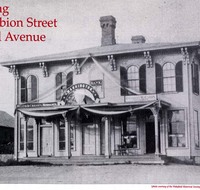 Bank building, corner of Albion Street and Railroad Avenue, circa 1868
Bank building, corner of Albion Street and Railroad Avenue, circa 1868 "The South Reading Mechanic and Agricultural Institution and the National Bank of South Reading, were both located in the Bank Building at the corner of Albion Street and Railroad Avenue, now North Avenue. The hours of operation for both banks were 8 to 11:30 a.m. and 2:30 to 4:30 p.m. every weekday. The South Reading Mechanical and Agricultural Institution was incorporated in 1833 and was the first bank to open in the town. It opened witha capital of $10,000 and in 1885, the interest rate was '4 per centum interest per annum, paid on deposits, beginning on the first of each month.' It was established two years after the Reading M & A Institution, a banking institution described as a bank of discount and deposit. The Reading bank's customers were largely 'engaged in trade with the Southern States.' The National Bank of South Reading, was organized as a State bank, the South Reading Bank, on May 16, 1854 with a capital of $100,000. It was reorganized as a National Bank in 1865. In 1902, the National Bank of South Reading changed its name to the Wakefield National Bank, and in 1916, it became the Wakefield Trust Company. It shared quarters with the Wakefield Savings Bank on Main Street from 1902 to 1924 when the Trust Company moved into its stately building at the opposite corner of Main and Chestnut Streets." -- Text from calendar by Jayne M. D'Onofrio.
-
 Bandstand, circa 1895
Bandstand, circa 1895 "The Bandstand on Wakefield's lower Common was built in 1885 in response to a national beautification movement to raise standards for architecture and public space in America. It was built as part of the $10,000 Cornelius Sweetser bequest which provided money for park purposes. The newly formed park commission purchased two lots of land between the lake and Main Street (owned by heirs of John White and Thomas Emerson) for $2,000 and $1,800 respectively, and work on the park began under the direction of Ernest W. Bowditch of Boston. A total of $13,830.23 was expended to complete the extensive work at the park, of which the bandstand was a part. Known as the 'Park Music Pavilion' and 'The Pagoda', the bandstand is said to resemble a pavilion in Brighton England, although its turned posts and ornamental frieze are also of the Queen Anne-style. The structure is made if wood and dressed fieldstone and its dome top was painted 'in the color of the heart's blood of the indulgent taxpayer.' The bandstand was recently restored by the Wakefield Center Neighborhood Association." -- Text from calendar by Jayne M. D'Onofrio.
-
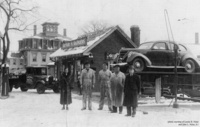 Arthur H. Saunders Gasoline Station, 40 Water Street, circa 1930s
Arthur H. Saunders Gasoline Station, 40 Water Street, circa 1930s "The gasoline station at 40 Water Street was owned by Arthur H. Saunders from the late 1920's until 1938 when an 'out-of-town' man bought the station, and owned it for one year. During Saunders' ownership, John L. Neiss managed the station, and, in 1939, he became its owner. The station was called the Center Service Station for its proximity to the Center (railroad) Station. The Center Service Station sold a complete line of Gulf products and specialized in 'scientifically-designed Gulflex lubrication.' By 1939, a 'heated lubritorium' was added which enabled attendants to give quicker and better service. In addition to the service station, John Neiss also conducted a range oil business, utilizing two oil trucks. Fuel oil remained a part of the business until World War II. Mr. Neiss owned the station until 1955 when it was sold to the Hubbard family. Gulf Oil leased land from the Boston & Maine Railroad and eventually a new Gulf station was built where the Center House in the background, once used a a hotel for guests and associates of Cyrus Wakefield, once stood." -- Text from calendar by Jayne M. D'Onofrio.
-
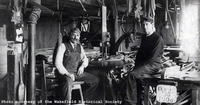 April, 1904
April, 1904 "The two gentlemen are unidentified, as is the location and nature of the business in which they were employed. It does provide an opportunity to see inside a shop or manufacturing company in the early years of the 20th century." - Text from calendar by Jayne M. D'Donofrio.
-
 Amoskeag Steamer, circa 1930
Amoskeag Steamer, circa 1930 "The Fire Department's Amoskeag Steamer works on the Nichols Ice House fire in a photo believed to be taken in 1930. The ice house was located on Main Street, Lakeside, opposite the Walton estate." -- Text from calendar by Jayne M. D'Onofrio.
-
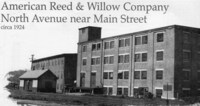 American Reed & Willow Company, North Avenue near Main Street, circa 1924
American Reed & Willow Company, North Avenue near Main Street, circa 1924 "The American Reed & Willow Company building was originally the Jenkins-Phipps Company, manufacturers of reed, rattan and willow furniture, which erected the building in early 1914, after purchasing the 1.5 acre property in December, 1913. The corner lot, originally part of the Cyrus Wakefield estate, was an ideal location because the Salem branch of the Boston & Maine Railroad passed by the doors of the company. The factory was a three- story wooden building, 100' long x 50' wide, which was built by local contractors A.A. Butler and W.E. Knox. The entrance faced southward, toward Crystal Lake. Jenkins-Phipps Company began as the A.D. Jenkins & Company on Franklin Street somewhere around 1890. Six employees built chairs and other rattan articles at the location until a fire forced the company to relocate to the Taylor Building around 1901, eventually expanding its operations to encompass the entire top fourth floor. Augustus Jenkins learned his trade as a worker and foreman for the Heywood Brothers and Wakefield Company of Gardner, a craft which brought him to Wakefield. His partnership with Irvin E. Phipps, a leading salesman for the Heywood Brothers and Wakefield Company, began in 1903. In what was termed as 'one of the most important industrial transactions in Wakefield,' the chair factory and business was sold to Pierce & Foley of Boston and New Jersey in June, 1919. At the time of purchase, they built a brick four-story addition on the north end of the factory to double the floor space. A fire in April, 1920, occurred in the original factory building, although the company quickly rebuilt, eventually opening a finishing and upholstery department in Boston, leaving the Wakefield location for manufacturing purposes only. The company later became known as the American Reed & Fibre Furniture Company. Changes in furniture design and market led to the company's decline in the late 1930s. By 1942, the company was idle and the property purchased by William Hickey of the Thomas Hickey Coal and Oil Company and Diamond Tank & Welding Company, in 1943. The three-story wooden building at the front was torn down in 1946 and a new front added. The location has also housed the Diamond Instrument Company (which made seismographs to study earthquakes), the Ellis Allen Company (makers of rubber rollers), and was secretly used to make radar products for Raytheon Company during World War II." -- Text from calendar by Jayne M. D'Onofrio.
-
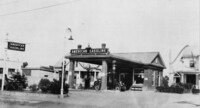 American Gasoline & Oil, Co., Wakefield Junction, 1931
American Gasoline & Oil, Co., Wakefield Junction, 1931 "Gasoline stations were evident on many street corners in business districts, including this one at 564 Main Street, at the junction of North Avenue, Main Street and Nahant Street. In 1930, American Gasoline & Oil Co. advertised gasoline prices at $.15 per gallon, at their Wakefield 'filling station.' In 1934, the advertised prices dropped to $.13 per gallon with tax, and $.12 1/2 per gallon for American Anti-Knock. Their 2,000,000 gallon waterfront storage plant and cargo purchases made it possible to market at those prices. They also referred to themselves as 'American Gasolene'. They took pride in the fact that their 'prompt and courteous attendants' took care of tires, put water in the radiators, and put 'real distilled water' in customer's batteries. Their price for a quart of American Paraffin Base Oil was $.20 for medium and heavy, and $.25 for extra-heavy. The company also operated three stations in other communities, including Salem Street in Reading, Main Street in Wilmington, and Revere Parkway in Everett." -- Text from calendar by Jayne M. D'Onofrio.
-
 Albion Street, circa 1931
Albion Street, circa 1931 "At first glance, Albion Street in the early 1930's looks much the same as it does now. On further inspection, the differences become apparent. Both Albion Street and Foster Street were two-way streets, now both one-way. The Wakefield Daily Item building, built in 1912, had its entrance at the corner of Albion and Foster Streets. In 1933 and 1934, the company purchased the two parcels of property west of the original building, site of the Atherton grocery store and later the Champagne furniture store. The properties were razed and the addition to the building was completed in 1935. The Hibernian Building was purchased by Division 26 of the Ancient Order of Hibernians in September, 1924, the upper levels used as the meeting hall and headquarters, and the ground floor rented to stores. In 1931, the stores included The Great Atlantic & Pacific Tea Company and what may have been the Bellevue Shoppe which was located there in 1925. Next to Grace Hardware, what is now a store was once a garage." -- Text from calendar by Jayne M. D'Onofrio.
-
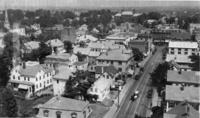 Albion Street, 1930
Albion Street, 1930 "This view of Albion Street may have been photographed from the Methodist Church which was located on Albion Street until the late 1930's. Although several homes were located along the lower portion of Albion Street, the area was a thriving business section, housing such enterprises as Reid's Market at 77 Albion Street, Spero Bros. Bedding at 11-13 Albion Street, Charles J. Martin (which advertised motorcycle repairs and skate sharpening), and J. Wallace Grace Co. at 14-18 Albion Street. The latter offered 'shoe skate outfits'." -- Text from calendar by Jayne M. D'Onofrio.
-
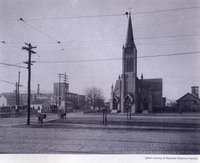 Albion Street at Railroad Avenue, 1908
Albion Street at Railroad Avenue, 1908 "Now one of Wakefield's busiest intersections, the Albion Street and North Avenue (known as Railroad Avenue until 1910) area appears to be quite tranquil in 1908. The railroad crossing was operated by an attendant who opened and closed the gates when a Boston and Maine train was approaching or departing from the station. The attendant's station is at the left of the photo. Several businesses were located in this area, the most prominent being the Harvard Knitting Mills, which appears at left in the photograph. Owned and operated by Elizabeth E. Boit and Charles N. Winship of Winship, Boit & Company, Harvard Knitting Mills moved to Wakefield in 1889, and to the Lake Street and Albion Street location in 1897. The firm would eventually occupy more than eight acres of space after several additions were made during a 20 year period. St. Joseph's Church, in the center of the photograph, owned much of the land bounded by Albion, Gould, Murray and West Chestnut Streets. The first parcel of land was purchased for the church in 1851 and a church was built soon after. During a five year period, from 1868 to 1873, 22,000' of land along Albion, Murray and Gould Streets was secured. A new house of worship, which was built in 1870, was moved closer to the railroad tracks, a basement was added and the building was turned to face the main thoroughfare, Railroad Avenue. The church building was lengthened by 75' with the addition of a nave in 1889. The cornerstone was laid on September 8, 1889, and the dedication was held in 1890. Additional land purchases were made in 1891 and 1892. Tuttle Street, 'a fine roadway cut by the railroad corporation,' was created in the mid-1890's. The first home of the parish (to the right of the church in the photo) was moved to Murray Street where it became Lyceum Hall, and later, the church hall." -- Text from calendar by Jayne M. D'Onofrio.
-
 Albion Diner, circa 1940
Albion Diner, circa 1940 "The Albion Diner at 23 Albion Street opened for business in November, 1935. The diner replaced Clifford Mortimer's lunch cart, 'the Dog Cart' which was located where the WMGLD Albion Street office now stands. Built by George Murphy and Walter Baltzer, the diner was bought by Albert Thompson of Lowell and James Riley of Wakefield in August, 1936. The pair sold the diner to Wakefield resident Ray Orde just a few months later. The diner was reported to be a 'favorite eating place' of many Wakefield residents and enjoyed a 'steadily expanding business.' In 1942, it was noted that table service was available for those who preferred not to sit at the counter. At the same time, it was said that 'whether a patron orders a sandwich or a complete dinner, he is assured of courteous and satisfactory service by the several counter men employed at the Albion Diner.' Ray Orde owned the diner until 1964 when the Wakefield Trust Company purchased three parcels of land behind the bank, including the diner, to build a 26-car parking lot. A public auction failed to find a buyer for the building in April, 1964, and on June 25th, 1964, the landmark diner was demolished, along with homes at 6 and 8 Chestnut Street." -- Text from calendar by Jayne M. D'Onofrio.
-
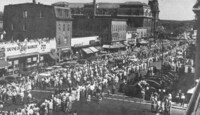 4th of July Parade 1953
4th of July Parade 1953 "Thousands of spectators watched the 4th of July Parade along the route that started at the West Side Social Club headquarters and ended at the Common. It was said to be the 'largest crowd ever.' In the center of the photo is a new 1953 Chevrolet which was awarded to a lucky winner after the fireworks. It was preceded by an old Chevy with a sign 'This Is Not It' which was said to have delighted the crowd. A panel of three judged the floats, and the top prize winner of $75 was the American Legion with its circus wagon, complete with two 'wild' animals, performers, clowns, balloons and circus music. Its theme was 'The American Way of Life.' Winning second prize of $50 was the Wakefield V.F.W. Post with its theme, 'Where is Your Son?' which was said to strike a 'poignant note to the heart' of those parents whose sons were fighting in the Korean War, were prisoners of war at the time, or who had lost their lives. Third and fourth place winners of $35 and $25 respectively, were the Red Men, with their depiction of an Indian Village 'World Need Smoke Peace Pipe,' and the Crystal Community Club, with its theme of how healthy play for children is one of the freedoms of living in the United States. Surrounding the Statue of Liberty were the members of the club's Little League team. The festivities began on July 3rd with a doll carriage parade at 7 p.m. followed by a block dance and concert featuring Colman's Orchestra from 8-11 p.m., a firefighter pole slide and hose race at 8:15, a bonfire and firefighting exhibition at 10:15, conculding with the aerial act and fireworks spray. On July 4th, the pet show, races, novelty events and free ice cream were held from 8:30 a.m. to 12 noon. The WSSC and WBZ-TV program began at 11:30 a.m. and the parade was kicked off with a 21-48 gun salute by a 155MM Howitzer at 2 p.m. The afternoon activites included a yacht race, aerial acts, drill exhibitions by Most Precious Blood and Norman Prince Post VFW, flyovers by a USAF plane and civilian air patrol aircraft, and a fireworks display." -- Text from calendar by Jayne M. D'Onofrio.
-
 42nd annual exhibition and prize drill, June 11, 1927
42nd annual exhibition and prize drill, June 11, 1927 "Members of the Wakefield High School Battalion participated in an annual exhibition and prize drill held at Wakefield Common. The 1927 event started with a parade from the Wakefield High School to the 'Park' led by the Lowell High School Regimental Band. Four companies were accompanied by 'young lady sponsors' who carried balloons and shakers of the colors of their respective companies. A small group of St. Joseph's cadets were also in the parade. The first event was the battalion review, followed by the exhibition in mass physical drill by all cadets, the senior competitive drill, the company competitive drill and the junior competitive drill. The individual winners of each drill received medals, some of which included the Wakefield medal (won by Walter Doyle), the Richardson Medal (won by Leo Beane) and the Walton Medal (won by Lawrence Churchill). Company B, Captained by George McMasters, won the company competitive drill for their execution of several difficult maeuvers 'in fine style, and for their proficiency in the manual of arms.' Several of the officers were awarded commissions at the conclusion of the event. Following the drill competition, the girls, dressed in their company's colors, marched around the field and presented the boys with balloons and shakers." -- Text from calendar by Jayne M. D'Onofrio.
-
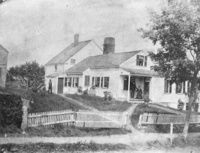 40 Salem Street, circa 1875
40 Salem Street, circa 1875 "The house at 40 Salem Street was occupied by the families of Ralph Woodward (pictured with his wife at right), and Henry Sweetser (at left, with his wife in the center of the photo.) At the left, in the hammock, are E.A. Sweetser, and Herbert H. Sweetser." -- Text from calendar by Jayne M. D'Onofrio.
-
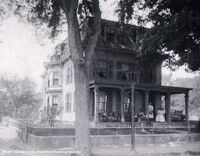 111 Albion Street, circa 1880s
111 Albion Street, circa 1880s "During the 1880s, James F. Woodward owned the house at 111 Albion Street. At the time, his property included a dwelling house, a stable, a tool factory, and nine to sixteen acres of land. It was here that he conducted a business, James F. Woodward & Son, manufacturer of shoe tools and machinery. James learned the trade from his father and his grandfather, Thomas Woodward, the first manufacturer of awls and other shoemakers' tools in America. James Woodward was the father of Lieut. Col. Charles F. Woodward, a leading proponent and president of the Wakefield Stoneham Street Railway Company. Charles was active in his native town, serving as president of the Citizens' Gas Light Company of Reading, South Reading, and Stoneham, and as president of the Wakefield Board of Trade. Politically he served as the Town's representative in the Massachusetts Legislature from 1887 to 1889, as Tax Collector and a member of the Board of Assessors." - Text from calendar by Jayne M. D'Donofrio.
-
 [Walton Field, aerial photo]
[Walton Field, aerial photo] "Walton Field, behind the Galvin Middle School, was the Wakefield High School athletic field until the current high school on Farm Street was opened in 1974. Soon after the completion of the new high school on Main Street, (now the Middle School), the athletic field was dedicated in honor of the Walton family in May 1926, prior to the start of a Saturday afternoon baseball game against Melrose. Money for the field was donated by Arthur and Mary Walton in memory of their son, Winship, who passed away in 1908. Arthur Gould Walton and his wife, Mary E. Bartlett Walton, both graduates of WHS, offered $10,000 to construct an athletic field which eventually cost $30,000. Mrs. Walton passed away in 1925 before the field was completed. Arthur G. Walton was the founder of A.G. Walton & Co., a shoe manufacturing firm. He inherited extensive real estate holdings throughout Wakefield, including the Walton and Gould business blocks. Arthur Gould Walton passed away in August 1937. The field was improved in the 1930s as part of the WPA program." -- Text from calendar.
-
 [Main Street, 1900]
[Main Street, 1900] "This solitary horse takes a drink from the horse trough on Main Street in 1900." -- Text from calendar.
-
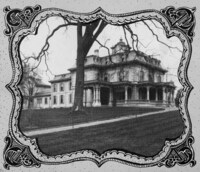 [Cyrus Wakefield mansion]
[Cyrus Wakefield mansion] "The Cyrus Wakefield Mansion was located on Main Street where the Wakefield Jr. High and Atwell Schools now stand. Cyrus Wakefield was instrumental in bringing the rattan industry to the town (then called South Reading) and generously donated the funds to build the former Town Hall located on the corner of Main and Water Streets. The town was renamed 'Wakefield' in 1868 in his honor." -- Text from calendar.
-
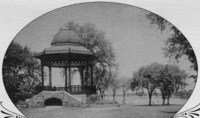 [Band stand on Wakefield Common]
[Band stand on Wakefield Common] Image from the Wakefield Municipal Gas and Light Department annual calendar, 1987
-
 Ye Barnard Inn, 8 Albion Street, circa 1925
Ye Barnard Inn, 8 Albion Street, circa 1925 "Formerly the Albion Inn, the Ye Barnard Inn, was located across the street from the current Wakefield Municipal Gas & Light Department offices. The inn was acquired by Mr. Barnard around 1925. In 1930, Mr. Barnard commissioned the firm of W.M. Brooks Company of Boston to change the structure into a two-story building at a cost of $7,500. The alterations included an office in the front of the second floor and an apartment at the rear. A store was 'made available' in the front of the building which was extended nearer to the sidewalk as far as the inner curbing bordered by the small garden maintained by Mr. Barnard." -- Text from calendar by Jayne M. D'Onofrio.
-
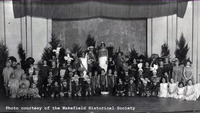 Wakefield Mothers' Club operetta, October 1930
Wakefield Mothers' Club operetta, October 1930 "The Wakefield Mothers' Club presented an operetta for children, Cinderella in Flowerland, or The Lost Lady's Slipper on Friday evening, October 24th and Saturday, October 25th at the Wakefield High School Auditorium. The operetta by Marion Loder featured Maria Costa as the Fairy, Pauline Erikson as Cinderella (Daisy) and Mary Lord and June Purcell as the Proud Sisters. Among the 63 cast members were Clara Giuliano, Priscilla Bourdon, Bertha Climo, Morris Stoddard, and Eleanor Davison. The operetta had four scenes: Princess Sunshine's invitation to the May Day ball Godmother Nature sends Daisy off to the ball the May Day ball and the shower and Princess of Sunbeam Castle. All tickets for the Friday performance cost 50 cents each, while Saturday's performance had a 25-cent ticket price for children. Bad weather was responsible for only half the seats being filled at both shows. According to Saturday's edition of the Wakefield Item, 'Catchy music, a variety of brilliant costumes and the strong appeal that child actors always make combined to make this first performance most pleasant.' The review also noted that the some [sic] of the 'little chorus flowers were as genuinely interested in the audience as it was in them.' " - Text from calendar by Jayne M. D'Donofrio.
-
 Wakefield Common, Old Home Week pageant, 1934
Wakefield Common, Old Home Week pageant, 1934 "Generations of Wakefield residents have gathered on the Wakefield common for band concerts, welcome home celebrations, sailboat and motorboat races, July 4th celebrations, and town anniversary celebrations. Wakefield's upper and lower commons were significantly improved with the addition of the bandstand and the improvements made through the bequest of Cornelius Sweetser in the 1880s. Many also gathered on the shores of Wakefield Quannapowitt [sic] from 1872 to the mid-1900s to rent sailboats and canoes, and to dance at the Wiley Boathouse and later the Hill Boathouse in the center of the picture. In the photo, the gentlemen are setting up for the Old Home Week Pageant sponsored by the Chamber of Commerce. In 1978, a Wakefield Item 'Looking Back' column focused on Lake Quannapowitt: 'Lake Quannapowitt, the town's recreational lake and one of the community's 20th century assets, has played an important role in local life for many, many years. At one time, the lake and its shores provided the core of summertime recreation and fun in an era that was slower paced and more serene.'" - Text from calendar by Jayne M. D'Donofrio.
-
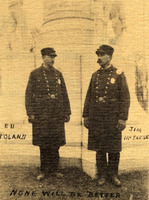 Wakefield
Wakefield "Wakefield has a rich history, peppered with an immense variety of facts and figures unique only to the community. Wakefield, as we know it today, was not always 'Wakefield', rather it has been known by four names: Lynn (or Linn) Village, Reading (or Redding), South Reading, and Wakefield. The present town government has evolved from a modified, democratic government, established in 1647 to the present day form of Board of Selectmen-Executive Secretary. The first Board of Selectmen was elected in 1647. Seven men were elected to the Board and for many years, according to the records, town meetings were limited to the daylight hours and a penalty was levied for non-attendance. Today, five Wakefield residents are elected to a staggered three year term on the Board of Selectmen and are assisted by a full-time professional administrator (the Executive Secretary) to carry out their directives. The Selectmen meet on a regular basis and are responsible for the major decisions affecting the town. Through the years, various municipal boards have been created to oversee the day-to-day operations of town departments. The Selectmen are responsible for public safety, general administration, recreation, and various special town committees and functions. The Executive Secretary for the town is appointed by the Board of Selectmen and as the Board's representative to all town departments acts as the liaison between the town and the state and federal governments. The Executive Secretary performs a variety of duties for the Selectmen and is responsible for such things as labor relations, personnel and data processing management, and the general responsibilities of complying with the policy decisions made by the Selectmen. Other directives are delegated to the town officials whose departments are responsible for various duties within the town. The Town Clerk prepares and supervises all elections, and records all vital statistics, registers voters, issues licenses, and oversees the annual census in conjunction with the Bo;Captions: 1. The atrium of the Cyrus Wakefield Town Hall which was erected in 1868 and later destroyed by fire. At left is a portrait of Mr. Wakefield, at right, a portrait of George Washington. -- 2. The 1901 Board of Selectmen - E.K. Bowser, Edward E. Lee, Richard Stout, Charles Walton, Capt. Tompson, and Col. Gihon. -- 3. The old Town Hall on the corner of Main and Water Street, 1930.
-
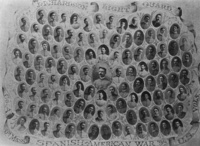 Spanish War veterans, Richardson Light Guard, 1898
Spanish War veterans, Richardson Light Guard, 1898 "This year marks the 100th anniversary of the Spanish-American War which was declared on April 26, 1898. This action followed Spain's oppressive treatment of Cuba's struggle for independence since 1895. The declaration of war by the United States against the Kingdom of Spain was the direct result of the 'blowing up' of the battleship Main in Havana Harbor in March. President McKinley called for 200,000 volunteers and 1,000,000 stepped forward to enlist. At that time, the US Army numbered 25,000. The Sixth Regiment of the Volunteer Militia of Massachusetts, of which Wakefield's Richardson Light Guard was a part, was the first regiment to offer its services to then Governor Wolcott. The Company held a special meeting on April 28th at which time 69 men enlisted. An additional 15 men joined the following day. On May 5th, the night before their departure, the townspeople hosted a grand farewell reception at the Town Hall. At 7:30 the next morning, the fire alarm rang the assembly signal (12-12), and the townspeople gathered again to escort the soldiers to the train station. School was closed for the day. The soldiers traveled through Boston, Baltimore, Virginia, South Carolina (where they boarded the 'Commodore Perry" to the 'Yale'), and Cuba. Their final destination was Puerto Rico where they were the first whole U.S. regiment to land, and were one of the 'few fortunate regiments to get under fire.' They were ordered home on October 18th, 1898 and arrived in Boston Harbor aboard the 'Mississippi' on October 27th. They arrived in Wakefield at dusk and were greeted by a 'dense mass' of people from Richardson Avenue to Yale Avenue. 'Red fire lighted up the sky; and with the discharge of dynamite salutes, the ringing of bells, the blowing of horns, discharge of fire works, and the music of two brass bands it was a rare spectacle.' The soldiers were honored at a banquet hosted by the Town on November 9, 1898. The Richardson Light Guard Association of the Puerto Rican Campaign was organized on January 2, 1899, and, on orders of the War Department, were quartered in the armory until mustered out. The men were required to report for roll call each morning and evening, and rations were furnished by a Lynn caterer. On January 21, 1899, the company traveled to the South Armory in Boston where they were mustered out of the U.S. service. It is interesting to note that because of the segregation of the U.S. Army at the time, African-Americans served in Company L of the 6th Regiment, and were trained in Boston. Wakefield resident, 2nd Lieutenant George W. Braxton, served with this Company." -- Text from calendar by Jayne M. D'Onofrio.
-
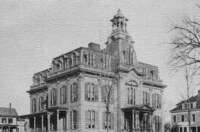 School department
School department "The Wakefield School Department has a history all its own. Responsible for the education of hundreds of thousands of school-age children over the years, the department's growth and development is indicative of the importance the town has placed on quality education. To adequately educate the growing number of students in Wakefield during the late 1800s and early 1900s, ten schools were erected, and by 1944, students enrolled in the Wakefield Public School System attended one of these schools: the West Ward School (1847) the Hamilton School (1883) the Lincoln School (1892) the Warren School (1897) the Greenwood School (1897) the Hurd School (1899) the Franklin School (1902) the Montrose School (1918) the Woodville SChool (1920) and the High School (the former Atwell School destroyed by fire in 1972 - built in 1923). A number of these schools have been expanded and remodeled since then. After 1944, the following schools were built: the Memorial Building (now the Junior High School), the new Atwell School, Doyle, Walton, Dolbeare, Yeuell and the Wakefield High School on Farm Street. Appropriations for the schools have changed from $2,700 in 1844 to $62,900 in 1910 to the 1986 appropriation of $12 million. The number of school personnel has also changed dramatically, from 107 teachers in 1944 to the present day number of 289. At the turn of the century, 1,896 students were enrolled in the Wakefield School system. Enrollment reached an all-time high in 1968, with 5,667 students and has dipped to 3,398 students for the 1986-1987 school year." -- Text from calendar.;Captions: 1. Wakefield High School, December 25, 1897 on the corner of Common and Lafayette Street. The building, formerly the Lafayette School, was remodeled in 1938 and became the Wakefield Town Hall in 1962. -- 2. The Old Academy Building which later became the High School. The Lincoln School now stands on the site. -- 3. The Warren School 1st grade, June 21, 1933.
-
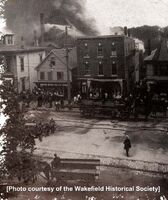 Rink fire, rear of 390 Main Street, July 21, 1900
Rink fire, rear of 390 Main Street, July 21, 1900 "A fire started in the varnish room of the Wakefield Reed Chair factory on Saturday, July 21st at 7:58 a.m. The building, owned by Emma Osgood, housed the factory, as well as the Wright & Dennis tennis factory which occupied the top floor of the building. Known as the 'Old Rink Building' it was once home to a roller skating rink from which it got its name, and was the seventh home of the Richardson Light Guard Armory, from 1877 to 1895. The Guard was ordered to remove all state property from the building when an inspection deemed the armory unfit for use in 1894. The fire was 'doomed from the start' and assistance came from three surrounding communities: Stoneham, Reading and Melrose. The fire destroyed the building, as well as Roger Howard's Carpenter Shop, a tenement occupied by Mrs. Abby Hawkes and family, two stables and a shed. Homes on Crescent Street were blistered and scorched and many families along Main Street and Crescent Street removed their furniture from their homes as a precautionary measure. The steeple of the First Universalist Church was destroyed, as was the roof. At the height of the fire, a southwest wind carried shingles 'high in the air.' The Saturday edition of the Wakefield Daily Item reported that 'some of the burning fire brands were carried to Lynnfield Center' where it was said they landed on the roof of a home. Although the building was assessed at $7,000, a total damage of all affected properties was estimated at $90,000." -- Text from calendar by Jayne M. D'Onofrio.
-
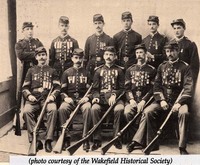 Reading Infantry Company and the Richardson Light Guard
Reading Infantry Company and the Richardson Light Guard "The first militia organized in Wakefield was a train-band known as the Reading Infantry Company, established in 1644, one year earlier than the Great and General Court order of 1645 which ordered all settlements to keep a military guard. This company remained active in various forms (infantry, cavalry and rifle companies) until 1840 when old militia laws were abolished and a new plan was adopted. During its nearly 200 year history, the Reading Infantry Company heeded the call and fought in several battles with several leaders, its first Captain being Richard Walker, its last Asaph Evans. In 1675 Reading troops marched against the Pequots in King Philips War in 1711 and 1745 they enlisted in armies which fought against the French and Indians in Nova Scotia and in 1774, 104 Reading men joined train-bands known then as the Minutemen. Of these 104, 86 officers and men fought under the command of Captain John Walton and their pastor Rev. Caleb Prentiss. These men went to Lexington on April 19, 1775 and were among the first troops to engage in battle when the British retreated from Concord. As the war continued, many men joined the army and navy and were at the battle of Bunker Hill, Ticonderoga, West Point, Long Island, among others. Captain James Bancroft of Reading was detailed to serve at Washington's headquarters in Cambridge and was with the 8th Massachusetts at Valley Forge. After the militia laws were abolished in 1840, volunteer systems sprang up throughout the Commonwealth and in 1849 a new military law was adopted by the State. Under the wise and vigorous administration of the leader of the militia, chosen in 1851, companies and regiments became more efficient. It was during this time that Wakefield's best known militia was formed. The Richardson Light Guard was officially established on October 11, 1851, one of only 14 new companies recognized by the office of the Adjutant-General. Three local youths, James F. Emerson, George O. Carpenter and Joseph L.R. Eaton, are credited with initiating a light infa
-
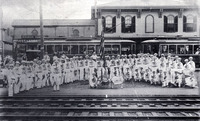 Railroad Street/North Avenue, circa 1890s
Railroad Street/North Avenue, circa 1890s "This group at the upper train station is not yet identifiable, but look resplendent with the American flag across the front of their uniforms. The gathering took place in front of the Eaton grocery store/bank building and the Railroad market, at the street railway tracks, across from the upper train station. In the 'Hand-Book of Wakefield,' published in 1885, a section was devoted to the Societies and Clubs. 'The Societies and Clubs of Wakefield (and there are many of them) exemplify the fact that Wakefield is noted for the congeniality of her citizens. In these clubs and organizations are drawn together the various little groups, having similar desires in mental, social and physical culture.' Societies and clubs of the times included, Wakefield Amateur Rifle Association Wakefield Lecture Association Victory Colony, No.23, United Order of the Pilgrim Fathers Neptune Lodge, No.137, Independent Order of Good Templars Chairmakers Benefit Association the Equity Associates of Wakefield and the Wakefield Chautauqua." - Text from calendar by Jayne M. D'Donofrio.
-
 Patrick J. McLaughlin, Wakefield Municipal Gas & Light Department's first gas supervisor
Patrick J. McLaughlin, Wakefield Municipal Gas & Light Department's first gas supervisor "Patrick J. McLaughlin was the gas department's superintendent when the Town of Wakefield purchased the privately-owned Citizens' Gas Company in 1894. His association with Wakefield's gas service began before the town's purchase, and at a 1935 banquet in his honor, he reflected upon his first encounter with the department. He recollected finding the gas holder on North Avenue on the ground, and working from Friday until Monday to get it standing. From then on, the old gas holder stayed put until it was dismantled in the early 1940s. Mr. McLaughlin was instrumental in servicing the needs of Wakefield's gas customers for nearly 50 years." -- Text from calendar by Jayne M. D'Onofrio.
-
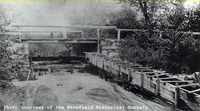 Fish Run, Montrose, 1890
Fish Run, Montrose, 1890 "The notation on the back of the photograph identifies the scene as the 'South River Fish Runway, Montrose' and the bridge as the 'bridge on the old road, north of the present street.' The writer probably meant the Saugus River, which flowed from Lake Quannapowitt (formerly Reading Pond and the Great Pond) into the ocean. The early settlers relied on the alewives that came up the Saugus River to Reading Pond to spawn. This food supply was nearly 'destroyed' when a dam was built at the Saugus Iron Works in 1675. Although efforts to block the dam were unsuccessful, the alewives continued to make the trip up the Saugus River, becoming abundant again well into the late 1800s and early 1900s. A Fish Committee, which regulated fishing on both Lake Quannapowitt and Crystal Lake, was established by the Town in 1876 in conformance with the regulations set by the State Commission who held the lease for the lake. In 1855, the ninth annual report filed by the Fish Commitee noted that 'true to wonderful instinct with which nature endows them, the alewives made their usual pilgrimage from the ocean to the lake at the accustomed time, notwithstanding the hindrances and cruelties which were inflicted on them.' In 1889, the report noted that there was little of interest to report, although the mill owners constructed a sluiceway at Hone's Dam, causing an obstruction of the first run of the fish." - Text from calendar by Jayne M. D'Donofrio.
-
 Dedication of the state armory, January 15, 1913
Dedication of the state armory, January 15, 1913 "More than 500 military and civilian guests, resplendent in their military regalia and evening dress, attended the dedication ceremony and banquet held at the new state armory. The chief speaker was then-Governor Eugene N. Foss. The great drill hall was decorated with the 'Stars and Stripes' and a platform was placed at the west end to accommodate the head table. A second head table was arranged at the foot of the platform as were white columns which supported arches of red, white and blue poinsettias, each illuminated with an electric lamp. During the evening, the guests toured the inside of the 'architectural ornament to the town'. On the north (right) side of the building was the company living room, the walls of which were finished in deep red. On the south side was the captain's, lieutenant's and first sergeant's rooms and officers' baths, with the armorer's room near the drill shed entrance. The north side of the upstairs housed the locker and equipment room, witha reading room at the front, which opened out onto the balcony. A committee room was in the southeast corner, with the noncommissioned officers room and bath located on the south side. The basement housed the kitchen and mess room, complete with pool tables, a bowling alley, four 75 foot rifle ranges and a large, gravel-floored room used for pitching tents. In 1975, the Town of Wakefield bought the armory for $1.00 from the Massachusetts National Guard. The name was changed to the Americal Civic Center in honor of the Americal Division which fought in the Pacific Theatre of Operations during World War II, including units from Company E of Wakefield. After extensive renovations, the building was reopened in 1976 and was used for meetings and office space. The building closed in 1981 because of the costs to operate the building. A group of local citizens conducted a study of the future use of the building and determined that it could be maintained as a self-sustaining builing. In 1983, a nonprofit corporation was established and has since been respo
-
 Dedication of Soldiers' and Sailors' Monument, Wakefield Common, June 17, 1902
Dedication of Soldiers' and Sailors' Monument, Wakefield Common, June 17, 1902 "Thousands of Wakefield residents and friends turned out for the dedication of the monument, made possible by a bequest of $10,000 in the will of Mrs. Harriet N. Flint. In her will, Mrs. Flint requested that the monument 'cost not less than $10,000 that it may be grand in itself, symmetrical in architecture, beautiful in design - a monument worthy of the true men to whom we dedicate it.' The town accepted the bequest in March 1898, and on March 4, 1901, the design of the Van Amringe Granite Company was accepted. The dedication exercises on June 17, 1902, featured Colonel E.J. Gihon as Chief Marshal. A parade, featuring veterans, military and civil organizations, was also held to commemorate the event." -- Text from calendar by Jayne M. D'Onofrio.
-
 Company A, Sixth Regiment Armory (Richardson Light Guard), Main & Water Street, circa 1895
Company A, Sixth Regiment Armory (Richardson Light Guard), Main & Water Street, circa 1895 "The Richardson Light Guard has a long and colorful history in Wakefield. Chartered in 1851, Company A, Sixth Regiment M.V.M. took as its local name 'the Richardson Light Guard' in honor of Dr. Solon O. Richardson. Historical references note that he had been 'zealously interested in the formation of the company and practically helpful in its membership.' The Richardson Light Guard was without a permanent home until 1894, when an armory was built by the Town just south of the corner of Main and Water Streets. Prior to that the company occupied quarters in several places, with the Town of Wakefield paying rent with a portion reimbursed by the state. On May 1, 1894, Town Meeting voted to appropriate $12,000 to build an armory. Soon after, a lot of land near the Town Hall and next to the Cutler Bros. grocery and grain stores was purchased. The building, complete with an attached drill shed, was dedicated on February 15, 1895. This armory was short-lived, however its demise the result of a fire which occurred on July 6, 1991 after a lightning bolt struck wires at the street corner, setting fire to Cutler Bros.' The flames spread quickly to the armory, but were kept from destroying the Town Hall and the Henry F. Miller & Sons Piano factory by the diligent efforts of firefighters. Total damage was set at $60,000. The armory fire did not 'burst out in real earnest' until the Cutler building was 'practically' flat. This allowed Company A members to rescue guns, live ammunition, uniforms, trophies, pictures and furnishings. When the fire spread to the upper story of the building, more than 2500 rounds of ammunition (all blank cartridges) exploded with the sounds of battle. After the fire, the company used the old Town Hall auditorium as a drill hall until a new armory was put into service aftr its dedication in January, 1913. The old armory is now the site of the Hodgdon Building. " -- Text from calendar by Jayne M. D'Onofrio.
-
 Classen Bros., Inc., 1930
Classen Bros., Inc., 1930 "John and Horace Dodge started in the automotive industry by supplying engines and transmissions to R.E. Olds, later selling engines, transmissions, and axles to Henry Ford for his automobiles. By 1913 Ford started producing these parts and adapting them to their own machines, leading to the Dodge Brothers producing their own automobile that was high in quality and durability at an affordable price. In 1928, Walter P. Chrysler bought the company after the brothers' deaths. The 1930 Dodge DD Six Business Coupe, advertised by Classen Bros. Inc. of Greenwood, had a factory price of $835. Power was supplied from a 6-cylinder 189.8 cubic-inch engine that provided just over 60 horsepower. Classen Bros., Inc. was located at 827 Main Street in Greenwood, later renumbered as 1099 Main Street. The dealership, which also sold Plymouths as well as Goodyear tires and tubes, was established in 1921." - Text from calendar by Jayne M. D'Donofrio.
-
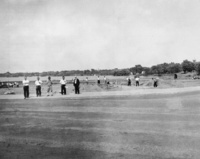 Building of Veteran's Field, circa 1934
Building of Veteran's Field, circa 1934 "Town Meeting voted to purchase land at North Avenue and Church Street following a huge fire on September 26, 1929, which destroyed most of the Porter-Milton Ice House. The fire, reported to have 'illuminated the whole town,' attracted hundreds of onlookers, many of whom had already made up their minds to buy the land for the Town to build a 'playground, bathing beach, bath house, and recreation park.' The loss of the icehouse was reported to exceed $50,000. A special Town Meeting was called for October 14th to purchase the land for the asking price of $15,000. The property extended from the corner of North Avenue and Church Street, up North Avenue to the 'old brook south of the Wakefield Ice Company and eastward up Church Street to the old Cemetery.' It also included a triangular lot of land (84' x 90' x 100') separate from the icehouse, across the west side of North Avenue, north of the gas plant. Included in the sale was the Lafayette House (now the Hartshorne House), the 'yellow house on Church Street on the lake side.' Approximately 100 voters attended the meeting and all but two voted to purchase the land. One opponent argued that the land was valued at $6,000 and the Town should take it by eminent domain. Funding came from the Town Treasury free cash (formerly known as surplus) which had a balance of $35,000. Within weeks, the stock market crashed, and soon after, the State Tax Commissioner said cities and towns would receive $5 million less the next year. Faced with dwindling funds, the Town's Park Commission needed help clearing the fire ruins, offering townspeople wood which was not totally consumed by fire. In 1934, initial plans called for a skating/hockey rink, ball field, tennis court and a general playground, with the work to be performed by the Civil Works Administration (CWA) which later became the ERA, a program designed to 'give relief to needy people through direct work or work relief.' These work projects were later shifted to the Works Projects Administration (WPA). The North Avenue - Church Street project was one of 92 completed projects carried out in Wakefield by the Federal government through 1935." -- Text from calendar by Jayne M. D'Onofrio.
-
 65th Annual Banquet, Company A, October 16, 1916
65th Annual Banquet, Company A, October 16, 1916 "The 65th Annual Banquet of the Richardson Light Guard Company A was held in the armory on Wednesday night, October 18th. Dinner started at 7:45 p.m. and was followed by remarks from the guest speaker, Adjutant General Gardner Pearson. Pearson spoke at length about the need for compulsory service, adding that all young men between the ages of 18 and 21 shold have some military training. The format for the evening was altered considerably from previous years, with the elimination of the speeches and toasts. At the conclusion of the formal remarks, the hall was cleared and the grand march began, the military section led by Captain and Mrs. Connelly, and the fine members led by Mr. and Mrs. Charles Walton. It was followed by a flashlight photograph of the more than 300 people in attendance taken from the balcony. The Military Ball began at 9:30 p.m. For those who did not wish to dance, whist and other games were played in the smaller rooms in the armory." -- Text from calendar by Jayne M. D'Onofrio.
-
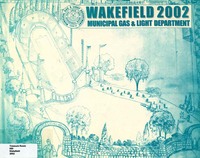 [Walton field stadium proposal]
[Walton field stadium proposal] "In 1945, an ambitious project was proposed for Walton Field which would create a new football stadium with seating for 25,000, new baseball grounds with a grandstand (moving the diamond to the northwest corner of the field), track, tennis courts, and a club house under the stands. The plan was made by Architect 'Johnnie' Rogers, a 'star' semi-pro baseball pitcher for the Wakefield Town Team. His plans called for a 'living memorial' to the men and women who were being discharged from the armed forces. The 'well-studied' plans called for two rustic, fieldstone entrance gates on the east side of the field and a new road along the south side of the high school, connecting Main Street and North Avenue. The stadium would be built of reinforced concrete with an outside surface of California stucco-effect. The plans also called for the future addition of stands which would be boxed in with shatter-proof glass, and a boiler room underneath which would supply heat through long coils. A field house, 'sanitary and well-lighted' would be located on the westerly side of the field. Although boosters of the plan said that the project would pay for itself in 'leaps and bounds,' the $250,000 project never got off the ground." -- Text from calendar.
-
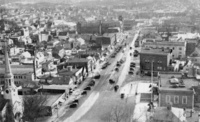 [Aerial photo of Wakefield business district, 1930s]
[Aerial photo of Wakefield business district, 1930s] Image from the Wakefield Municipal Gas and Light Department annual calendar, 1995
-
Pleasure Island, 1961
Pauline Sheehan (35) holding son Keith (5 1/2 mos.)
Pleasure Island Amusement Park, Wakefield, MA, July 2, 1961
-
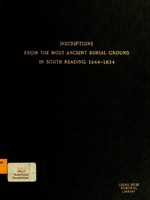 Inscriptions from the most ancient burial ground in South Reading, 1644-1834
Inscriptions from the most ancient burial ground in South Reading, 1644-1834 Typed by a government project.
-
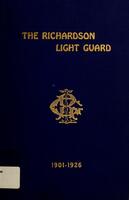 History of the Richardson Light Guard of Wakefield, Mass., covering the third quarter-century period, 1901-1926 :published under the direction and authority of the General Committee on the occasion of the seventy-fifth anniversary of the company, October 12, 1926
History of the Richardson Light Guard of Wakefield, Mass., covering the third quarter-century period, 1901-1926 :published under the direction and authority of the General Committee on the occasion of the seventy-fifth anniversary of the company, October 12, 1926 317 pages : illustrated
-
 The Hartshorne House of ancient Redding in the Massachusetts Bay Colony
The Hartshorne House of ancient Redding in the Massachusetts Bay Colony On cover: The Hartshorne House of ancient Redding in Massachusetts Bay Colony
-
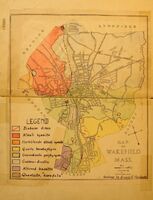 Geology of Wakefield, Massachusetts
Geology of Wakefield, Massachusetts View title in the Internet Archive
-
 A completed century, 1826-1926 : the story of Heywood-Wakefield Company
A completed century, 1826-1926 : the story of Heywood-Wakefield Company 111 pages : illustrated
-
 The Lucius Beebe Memorial Library : an historical sketch
The Lucius Beebe Memorial Library : an historical sketch 39, [1] pages including frontispiece (mounted portrait), 2 mounted plates
-
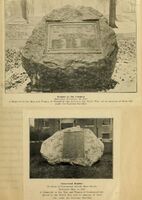 Wakefield Massachusetts in the World War, 1917-1920
Wakefield Massachusetts in the World War, 1917-1920 First compiler was Emma Florence Eaton who worked on the project from 1919-1921. The work was resumed in 1935 under a W.P.A. project, sponsored by the Town Fathers and Project Supervisor J. Theodore Whitney. (from the introduction)
-
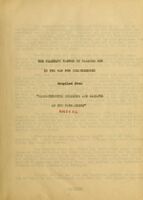 The military record of Reading men in the War of Independence
The military record of Reading men in the War of Independence View title in the Internet Archive
-
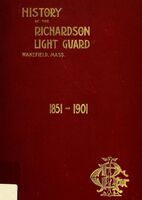 History of the Richardson Light Guard, of Wakefield, Mass., 1851-1901
History of the Richardson Light Guard, of Wakefield, Mass., 1851-1901 Preface signed: William E. Eaton; Pub. under the direction and authority of the General Committee on the occasion of the semicentennial celebration of the company, October 11, 1901.
-
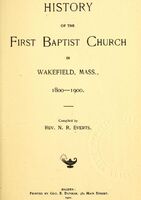 History of the First Baptist Church in Wakefield, Mass., 1800-1900
History of the First Baptist Church in Wakefield, Mass., 1800-1900 vii, 9-131, 2 pages : frontispiece
-
 The five meeting houses and early parsonages of the first parish of Old Reading, now Wakefield, Massachusetts, 1644-1937
The five meeting houses and early parsonages of the first parish of Old Reading, now Wakefield, Massachusetts, 1644-1937 View title in the Internet Archive
-
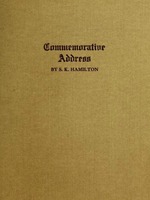 Commemorative address, by Samuel K. Hamilton, delivered at the celebration by the first parish in Wakefield, Massachusetts of the completion of payment covering the cost of the fifth meeting-house of the Congregational Church, Friday evening, February twenty-first, nineteen hundred & nineteen
Commemorative address, by Samuel K. Hamilton, delivered at the celebration by the first parish in Wakefield, Massachusetts of the completion of payment covering the cost of the fifth meeting-house of the Congregational Church, Friday evening, February twenty-first, nineteen hundred & nineteen 65 pages, frontispiece (portrait) : illustrations
-
 Wakefield memorial : comprising an historical, genealogical and biographical register of the name and family of Wakefield
Wakefield memorial : comprising an historical, genealogical and biographical register of the name and family of Wakefield xi pages, 2 leaves, 352 pages, 4 leaves including illustrations, portraits, maps, facsimiles, coat of arms
-
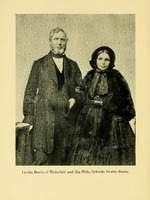 Lucius Beebe of Wakefield and Sylenda Morris Beebe, his wife, their forbears and descendants
Lucius Beebe of Wakefield and Sylenda Morris Beebe, his wife, their forbears and descendants xvii, 238 pages : frontispiece, plates, portraits, facsimiles, coat of arms
-
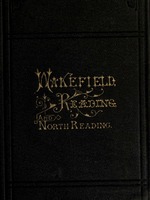 Proceedings of the 250th anniversary of the ancient town of Redding, once including the territory now comprising the towns of Reading, Wakefield, and North Reading : with historical chapters
Proceedings of the 250th anniversary of the ancient town of Redding, once including the territory now comprising the towns of Reading, Wakefield, and North Reading : with historical chapters 398 pages, [2] leaves of plates : illustrated
-
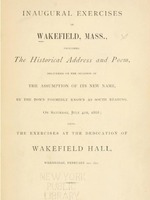 Inaugural exercises in Wakefield, Mass. : including the historical address and poem delivered on the occasion of the assumption of its new name, by the town formerly known as South Reading, on Saturday, July 4th, 1868
Inaugural exercises in Wakefield, Mass. : including the historical address and poem delivered on the occasion of the assumption of its new name, by the town formerly known as South Reading, on Saturday, July 4th, 1868 Half title: Proceedings at the inauguration of the town of Wakefield, July 4th, 1868.
-
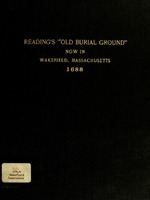 Reading's "Old Burial Ground" now in Wakefield, Massachusetts, 1688
Reading's "Old Burial Ground" now in Wakefield, Massachusetts, 1688 View title in the Internet Archive
-
 Vital records of Wakefield, Massachusetts, to the year 1850
Vital records of Wakefield, Massachusetts, to the year 1850 Alphabetical indexes to the manuscript records of the town, supplemented by information from church registers, cemetary inscriptions and other sources.
-
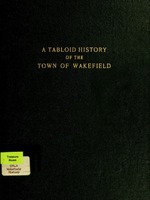 Tabloid history of the town of Wakefield
Tabloid history of the town of Wakefield View title in the Internet Archive
-
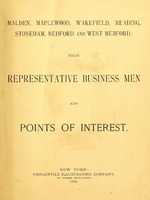 Malden, Maplewood, Wakefield, Reading, Stoneham, Medford and West Medford : their representative business men and points of interest
Malden, Maplewood, Wakefield, Reading, Stoneham, Medford and West Medford : their representative business men and points of interest 127 pages : illustrated
-
 Wakefield, Massachusetts tercentenary : a history, 1644-1944
Wakefield, Massachusetts tercentenary : a history, 1644-1944 Cover-title: Wakefield, Massachusetts tercentenary; a history, 1644-1944. History of Wakefield (Middlesex county) Massachusetts,compiled by William E. Eaton and History committee. Published under the direction and authority of the Tercentenary committee of the town of Wakefield, Massachusetts.
-
 Hand-book of Wakefield, Mass. : a strangers' guide and residents' manual
Hand-book of Wakefield, Mass. : a strangers' guide and residents' manual vi, 116 p. : illustrated
-
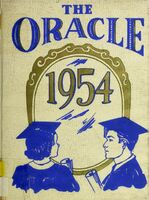 The Oracle
The Oracle 81 volumes, illustrated (some color)
-
 The Debater
The Debater 18 volumes : illustrated (some color)
-
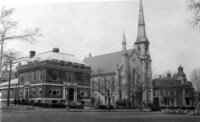 YMCA, Baptist church, Lafayette bldg., April 1930
YMCA, Baptist church, Lafayette bldg., April 1930
-
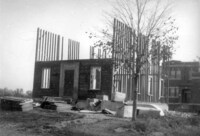 Tearing down old Woodville School, 1920
Tearing down old Woodville School, 1920
-
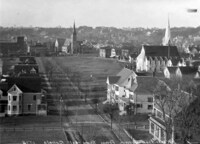 View looking west from top of Town Hall, 1896
View looking west from top of Town Hall, 1896
-
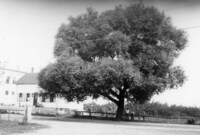 [Willow tree on Water Street]
[Willow tree on Water Street] Photograph taken on July 19,1931.;"This willow tree grew from a stake driven in the ground 4 ft. x 2" by road builders about 1906. #87 Water Street at left." - Text from back of photograph.
-
 [Walsh's Diner, Wakefield, Mass.]
[Walsh's Diner, Wakefield, Mass.] Photo shows Walsh's Diner, located at the corner of Main and West Water Streets, on what is now the parking lot of Eastern Bank. It operated from 1936 until 1950.
-
 [L.B. Evans' Son Co. Shoe Manufacturers, Wakefield, Mass.]
[L.B. Evans' Son Co. Shoe Manufacturers, Wakefield, Mass.] Photograph shows L.B. Evans' Son Co. Shoe Manufacturers on Water Street. Also visible is the Arthur H. Saunders Gulf service station. The factory building was sold in 1979 and the company phased out its operations. It has since been converted for office use.
-
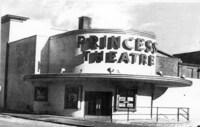 [Princess Theatre, Wakefield, Mass.]
[Princess Theatre, Wakefield, Mass.] Photo shows the Princess Theatre, which opened on Mechanic Street (later Princess Street) in 1912. The building was torn down in 1971.
-
 [Fred's Service Station, Wakefield, Mass.]
[Fred's Service Station, Wakefield, Mass.] Photo shows Fred's gas station, located at the corner of Main and West Water Streets, on what is now the parking lot of Eastern Bank.
-
 [Walsh's Diner, Wakefield, Mass.]
[Walsh's Diner, Wakefield, Mass.] Photo shows Walsh's Diner, located at the corner of Main and West Water Streets, on what is now the parking lot of Eastern Bank. It operated from 1936 until 1950.
-
 Aerial drawing of Cyrus Wakefield Estate, Wakefield, Mass.
Aerial drawing of Cyrus Wakefield Estate, Wakefield, Mass. Image is a portion of a drawn aerial map showing the Cyrus Wakefield estate once located on Main Street on the site of the present Galvin Middle School. The mansion was sited approximately opposite Richardson Street, on what is now the school parking lot. The Wakefield estate covered hundreds of acres on both sides of Main Street, and included most of the land bounded by West Water Street, Main Street, and North Avenue, as well as most of the land between Water Street and Bennett Street. The large stone mansion was built in the early 1860s in Second Empire mansard style, and was complemented by a barn, gazebo, greenhouses, canals and orchards on the grounds which extended back to North Avenue. Cyrus Wakefield died in 1873, and the house was then occupied by his widow, Eliza Bancroft Wakefield, who died in 1877. The estate passed into the hands of relatives, as Cyrus and Eliza had no children. The Town voted to buy the property in 1913 at a cost of $25,000. A few years later, the town voted to use the property as the site for a new school building. The mansion, which had fallen into disrepair, was torn down on October 17, 1921.
-
 Map of Cyrus Wakefield Estate, Wakefield, Mass.
Map of Cyrus Wakefield Estate, Wakefield, Mass. Image is a portion of a map showing the Cyrus Wakefield estate once located on Main Street on the site of the present Galvin Middle School. The mansion was sited approximately opposite Richardson Street, on what is now the school parking lot. The Wakefield estate covered hundreds of acres on both sides of Main Street, and included most of the land bounded by West Water Street, Main Street, and North Avenue, as well as most of the land between Water Street and Bennett Street. The large stone mansion was built in the early 1860s in Second Empire mansard style, and was complemented by a barn, gazebo, greenhouses, canals and orchards on the grounds which extended back to North Avenue. Cyrus Wakefield died in 1873, and the house was then occupied by his widow, Eliza Bancroft Wakefield, who died in 1877. The estate passed into the hands of relatives, as Cyrus and Eliza had no children. The Town voted to buy the property in 1913 at a cost of $25,000. A few years later, the town voted to use the property as the site for a new school building. The mansion, which had fallen into disrepair, was torn down on October 17, 1921.;Image is from a map presumed to be a sheet (page 61) from an atlas of Middlesex County, published by George H. Walker of Boston.
-
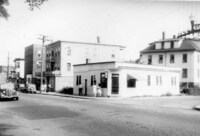 Corner of Water St. & Wakefield Ave., July 23, 1945
Corner of Water St. & Wakefield Ave., July 23, 1945
-
 [Vernon Market]
[Vernon Market] Undated photograph looking west shows the Vernon Market at the corner of Vernon Street and Lawrence Street. The building now contains apartments.
-
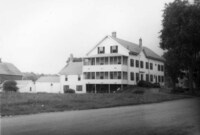 Wakefield town farm, Nahant St, July 13, 1931
Wakefield town farm, Nahant St, July 13, 1931
-
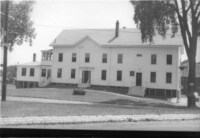 Wakefield town farm building, July 5, 1947
Wakefield town farm building, July 5, 1947
-
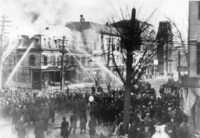 George H. Taylor store fire, Mar. 5, 1907
George H. Taylor store fire, Mar. 5, 1907
-
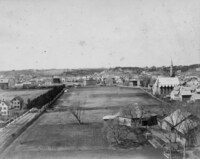 Solon Richardson's round stable : site of Richardson Ave., Wakefield, Mass.
Solon Richardson's round stable : site of Richardson Ave., Wakefield, Mass.
-
 St. Joseph's School flag raising
St. Joseph's School flag raising Photograph taken on May 8, 1936 shows a flag raising ceremony at the school of St. Joseph's Roman Catholic Church on Gould Street.
-
 Rattan factory workers
Rattan factory workers
-
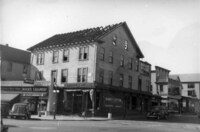 Perkins Block being torn down, Oct. 29, 1940
Perkins Block being torn down, Oct. 29, 1940
-
 The Payros
The Payros Photograph taken in November, 1909 shows three members of the Payro family being "photographed" by their cat: Edmund, age 12, Ernest, age 8, and Cecilia, age 5.
-
 Taylor Block, Town Hall, piano factory, Sept. 1929
Taylor Block, Town Hall, piano factory, Sept. 1929
-
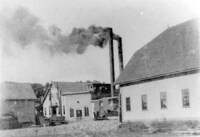 Old street railway car barns & power house
Old street railway car barns & power house Photograph taken in 1895 shows a rear view, looking north, of the car barns and power house for the street railway cars on Water Street.
-
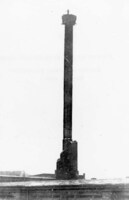 Man on top of rattan factory chimney
Man on top of rattan factory chimney Photograph taken in 1900 shows a man on top of the remains of the chimney of the Wakefield Rattan Company factory on Water Street. The approximately 180-foot chimney had been struck by lightning on March 12, 1899.
-
 Near Crystal Lake
Near Crystal Lake Photograph taken on December 24, 1939 shows a locomotive heading south towards Melrose along the shore of Crystal Lake in Greenwood. The Harts Hill forest fire watch tower is visible in the upper right.
-
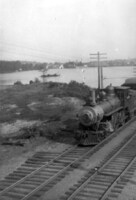 View from Greenwood Bridge
View from Greenwood Bridge Photograph taken in 1916 shows a locomotive heading south towards Melrose along the shore of Crystal Lake in Greenwood.
-
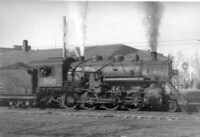 [Locomotive at Center Depot]
[Locomotive at Center Depot] Photograph taken on February 21, 1938 at 10 a.m. shows a railroad lococomotive at Wakefield's Center Depot on Water Street.
-
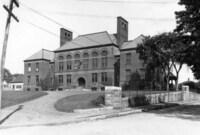 Lincoln School
Lincoln School Photograph taken on August 5, 1905 shows the Lincoln School at the corner of Crescent and Otis Streets. The school was built in 1892 and is now used for elderly housing.
-
 Bayrd's Indian Trading Post at 52 Main Street, Wakefield, Mass.
Bayrd's Indian Trading Post at 52 Main Street, Wakefield, Mass. Detailed entry in building survey, "The cultural resources of Wakefield", pA4.;Photo courtesy of the Bayrd family.
-
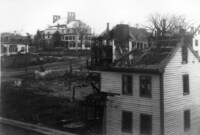 Hathaway stable fire ruins, Oct. 23, 1899
Hathaway stable fire ruins, Oct. 23, 1899
-
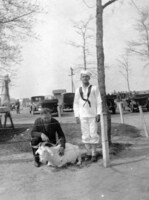 [Wakefield Rifle Range mascots]
[Wakefield Rifle Range mascots] Photographs shows members of the Wakefield Rifle Range, formerly Camp Plunkett, with animal mascots. In one photo a goat, and in the other a parrot.
-
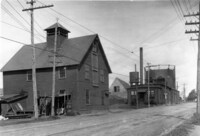 Gas house on North Avenue
Gas house on North Avenue
 Bear Hill Golf Club, circa 1900 "According to the history published for the Wakefield Tercentenary observance, residents in the newly established Park Section of Wakefield organized a country club soon after the area was developed by Stendman Hanks. Headquartered on Morrison Road, the Bear Hill Golf Club moved to its first home on Hopkins Street in 1900, where a club house was built and a nine-hole golf course laid out. The Club purchased additional land in 1913, and, to meet the needs of the increasing membership, erected a new club house in 1920 on the south side of Prospect Street. A new nine-hole golf course was laid out. Several additional purchases of adjacent land over the years resulted in the lengthening of the golf holes. The second club house was destroyed by fire in 1939, and members rebuilt the clubhouse on the same site, using the existing foundation." -- Text from calendar by Jayne M. D'Onofrio.
Bear Hill Golf Club, circa 1900 "According to the history published for the Wakefield Tercentenary observance, residents in the newly established Park Section of Wakefield organized a country club soon after the area was developed by Stendman Hanks. Headquartered on Morrison Road, the Bear Hill Golf Club moved to its first home on Hopkins Street in 1900, where a club house was built and a nine-hole golf course laid out. The Club purchased additional land in 1913, and, to meet the needs of the increasing membership, erected a new club house in 1920 on the south side of Prospect Street. A new nine-hole golf course was laid out. Several additional purchases of adjacent land over the years resulted in the lengthening of the golf holes. The second club house was destroyed by fire in 1939, and members rebuilt the clubhouse on the same site, using the existing foundation." -- Text from calendar by Jayne M. D'Onofrio. Bayrd's Indian Trading Post, Main Street, circa 1985 "Bayrd's Indian Trading Post on Main Street, opposite Lake Quannapowitt, was a Wakefield landmark from the time it was built in 1954 until it was razed on August 17, 1995. Designed, owned and occupied by E. Leonard (Lenny) Bayrd, a half Narragansett Native American also known as Chief Wamblesakee (Eagle Claw), the building was a home as well as a craftshop where Lenny and Ruth Bayrd made authentic Native American artifacts and costumes. When the Bayrds purchased the brush-filled property at the head of Lake Quannpowitt in the early 1950s, it was occupied by a teahouse. After Lenny retired from a 27-year career as a letter carrier in December 1954, the couple turned a hobby into a full-time career when they moved into the new house attached to the twin-teepee flanked shop. His 'elaborate beaded costumes and gaily-colored feather bonnets' were featured in a national magazine in 1954. For more than 35 years, the shop was frequented by other Native Americans, fellow members of the Order of Red Men, members of the Wahpatuck Tribe of Red Men's Band, and local residents. Bayrd also made the headdresses and costumes worn by the Wakefield high School Majorettes for many years as well as costumes and headdresses worn by by Saugus High School cheerleaders, Western movie stars, rodeo performers and Buffy Sainte-Marie, a well known singer and former Wakefield resident. Although as a Native American, Lenny was able to obtain eagle feathers from the Department of Fish and Game that he used in his headdresses and costumes, the eagle-feathered items could only be sold to other Native Americans or passed down to family members. In addition to the couple's handiwork that was known throughout the country and Europe, the shop contained displays of many artifacts that had been found in Wakefield. Among those artifacts were plummets found in Lake Quannpowitt once used to weigh down fishing nets, arrowheads and a grommet (a stone with two holes which was worn around the neck which identified the wearer as a messenger not to be harmed) found on Parker Road. Following Lenny Bayrd's death in 1990 and Ruth Bayrd's death in 1991 the property was sold to the Gingerbread Construction Company in 1995.' " -- Text from calendar by Jayne M. D'Onofrio.
Bayrd's Indian Trading Post, Main Street, circa 1985 "Bayrd's Indian Trading Post on Main Street, opposite Lake Quannapowitt, was a Wakefield landmark from the time it was built in 1954 until it was razed on August 17, 1995. Designed, owned and occupied by E. Leonard (Lenny) Bayrd, a half Narragansett Native American also known as Chief Wamblesakee (Eagle Claw), the building was a home as well as a craftshop where Lenny and Ruth Bayrd made authentic Native American artifacts and costumes. When the Bayrds purchased the brush-filled property at the head of Lake Quannpowitt in the early 1950s, it was occupied by a teahouse. After Lenny retired from a 27-year career as a letter carrier in December 1954, the couple turned a hobby into a full-time career when they moved into the new house attached to the twin-teepee flanked shop. His 'elaborate beaded costumes and gaily-colored feather bonnets' were featured in a national magazine in 1954. For more than 35 years, the shop was frequented by other Native Americans, fellow members of the Order of Red Men, members of the Wahpatuck Tribe of Red Men's Band, and local residents. Bayrd also made the headdresses and costumes worn by the Wakefield high School Majorettes for many years as well as costumes and headdresses worn by by Saugus High School cheerleaders, Western movie stars, rodeo performers and Buffy Sainte-Marie, a well known singer and former Wakefield resident. Although as a Native American, Lenny was able to obtain eagle feathers from the Department of Fish and Game that he used in his headdresses and costumes, the eagle-feathered items could only be sold to other Native Americans or passed down to family members. In addition to the couple's handiwork that was known throughout the country and Europe, the shop contained displays of many artifacts that had been found in Wakefield. Among those artifacts were plummets found in Lake Quannpowitt once used to weigh down fishing nets, arrowheads and a grommet (a stone with two holes which was worn around the neck which identified the wearer as a messenger not to be harmed) found on Parker Road. Following Lenny Bayrd's death in 1990 and Ruth Bayrd's death in 1991 the property was sold to the Gingerbread Construction Company in 1995.' " -- Text from calendar by Jayne M. D'Onofrio. Bay State Military Rifle Association, circa 1906 "'Systematic instruction' in military rifle shooting was deemed essential by the government in 1875. As a result, the Massachusetts Volunteer Rifle Association was created and the first military rifle competition in the state was held in the South Framingham Campground. The Richardson Light Guard rifle team was organized in July 1878 and went on to take first place in the Regimental Matches from 1890 to 1907, as well as in many other significant matches. Company A's first permanent range was located in the rear of the Wakefield Rattan Company, with an established range of 200 yards. The local Militia was issued Model 45/70 Springfield breech loading rifles. State qualification requirements called for shooting at greater distance, and as a result, the local company moved to the Massachusetts Rifle Association range at Walnut Hill in Woburn. In 1891, the Selectmen vote to permit firing at the required 500 and 600-yard distances enabling the company to return to Wakefield. This was short-lived as the area became more densely populated. The Cox Woods, at the corner of Haverhill and Pine Streets (now Bay State Road), was selected by the company as the site of its new range and it was soon equipped with a shooting house and 200, 500 and 600-yard ranges. The Wakefield range became home to the Massachusetts State Rifle Team after it left Walnut Hill. The range so impressed the Inspector general of the Rifle Practice that a canvas of top military men was taken, and the Bay State Military Rifle Association was established. The association paid the town $200 each year for the remaining two years of the Town's lease and allowed the local rifle company to use its facilities. The facility was used as a rifle range for the US Navy during World War I. The Commonwealth of Massachusetts took over the range in 1925 and the name was changed to Camp Curtis Guild to honor Massachusetts Governor Curtis Guild, Jr. During World War II, extensive changes were made and the camp was used for military training and as a mobilization and overseas evacuation point." -- Text from calendar by Jayne M. D'Onofrio.
Bay State Military Rifle Association, circa 1906 "'Systematic instruction' in military rifle shooting was deemed essential by the government in 1875. As a result, the Massachusetts Volunteer Rifle Association was created and the first military rifle competition in the state was held in the South Framingham Campground. The Richardson Light Guard rifle team was organized in July 1878 and went on to take first place in the Regimental Matches from 1890 to 1907, as well as in many other significant matches. Company A's first permanent range was located in the rear of the Wakefield Rattan Company, with an established range of 200 yards. The local Militia was issued Model 45/70 Springfield breech loading rifles. State qualification requirements called for shooting at greater distance, and as a result, the local company moved to the Massachusetts Rifle Association range at Walnut Hill in Woburn. In 1891, the Selectmen vote to permit firing at the required 500 and 600-yard distances enabling the company to return to Wakefield. This was short-lived as the area became more densely populated. The Cox Woods, at the corner of Haverhill and Pine Streets (now Bay State Road), was selected by the company as the site of its new range and it was soon equipped with a shooting house and 200, 500 and 600-yard ranges. The Wakefield range became home to the Massachusetts State Rifle Team after it left Walnut Hill. The range so impressed the Inspector general of the Rifle Practice that a canvas of top military men was taken, and the Bay State Military Rifle Association was established. The association paid the town $200 each year for the remaining two years of the Town's lease and allowed the local rifle company to use its facilities. The facility was used as a rifle range for the US Navy during World War I. The Commonwealth of Massachusetts took over the range in 1925 and the name was changed to Camp Curtis Guild to honor Massachusetts Governor Curtis Guild, Jr. During World War II, extensive changes were made and the camp was used for military training and as a mobilization and overseas evacuation point." -- Text from calendar by Jayne M. D'Onofrio. Bath house, Lake Quannpowitt, 1940 "During the 1930's and 1940's many varied public works and construction projects were completed by the WPA (Works Progress Administration) within the Town of Wakefield. These projects ranged from the typing of Town records in 1934, to the remodeling of the Lafayette School into municipal offices and veterans' office quarters in 1937, to the construction of eight newly accepted streets and several sidewalks in 1937. In 1939, Wakefield Selectmen voted to ask the Special Town Meeting to build a bath house on Spaulding Street at Lake Quannapowitt, as well as other recreation projects, using ther skills of WPA workers at an estimated cost of $2,000. Just one week later, the estimated cost rose to $5,500 a fact that created debate within the community. The WPA Supervisor was asked to submit other plans which were not so elaborate which would 'entail a smaller expenditure to the Town and yet produce a satisfactory bath house,' the Selectmen feeling that the proposed bath house could not be erected for that amount of money. New plans were submitted by the Wakefield Rotary Club's community service committee which reduced the proposed costs from $5,500 to between $3,500 and $3,000. The building would not be made of brick as in the previous plans and would not be heated for winter use. The bath house could accommodate 100 boys and 100 girls and would be a modern building with asphalt shingles. On March 23, 1939, Special Town Meeting voted to build the bath house at a cost of $5,261 by a close vote. The Spaulding Street bath house was completed in 1940 for a cost of $6,882.59. The bath house was removed in 1994 to the Forest Glade Cemetery." -- Text from calendar by Jayne M. D'Onofrio.
Bath house, Lake Quannpowitt, 1940 "During the 1930's and 1940's many varied public works and construction projects were completed by the WPA (Works Progress Administration) within the Town of Wakefield. These projects ranged from the typing of Town records in 1934, to the remodeling of the Lafayette School into municipal offices and veterans' office quarters in 1937, to the construction of eight newly accepted streets and several sidewalks in 1937. In 1939, Wakefield Selectmen voted to ask the Special Town Meeting to build a bath house on Spaulding Street at Lake Quannapowitt, as well as other recreation projects, using ther skills of WPA workers at an estimated cost of $2,000. Just one week later, the estimated cost rose to $5,500 a fact that created debate within the community. The WPA Supervisor was asked to submit other plans which were not so elaborate which would 'entail a smaller expenditure to the Town and yet produce a satisfactory bath house,' the Selectmen feeling that the proposed bath house could not be erected for that amount of money. New plans were submitted by the Wakefield Rotary Club's community service committee which reduced the proposed costs from $5,500 to between $3,500 and $3,000. The building would not be made of brick as in the previous plans and would not be heated for winter use. The bath house could accommodate 100 boys and 100 girls and would be a modern building with asphalt shingles. On March 23, 1939, Special Town Meeting voted to build the bath house at a cost of $5,261 by a close vote. The Spaulding Street bath house was completed in 1940 for a cost of $6,882.59. The bath house was removed in 1994 to the Forest Glade Cemetery." -- Text from calendar by Jayne M. D'Onofrio. Baseball, 1945 "As one of the oldest, if not the oldest, sport at Wakefield High School, boys baseball was originally played on the Common. In 1900, the WHS baseball team won the state title by defeating Lawrence 18-8. Many of the members of the 1945 WHS baseball team, the first to be coached by Coach James Walsh, returned to the diamond the following year. While the 1945 team had five wins in 11 starts, the 1946 baseball team, captured the Middlesex League crown with a 14-3 record in its first year of play in the league. The team went on to play in the state competition at Fenway Park, beating Lawrence in the first game, and losing to Newton by a score of 4-2. During the season, pitcher Les DeMarco pitched two nine inning no-hitters. In 1954, the WHS baseball team made the record books when sophomore pitcher Ralph Lazzaro pitched a complete no-hitter in a game against Reading. The next day, the same feat was accomplished when Larry McShane pitched a no-hitter against Lexington." -- Text from calendar.
Baseball, 1945 "As one of the oldest, if not the oldest, sport at Wakefield High School, boys baseball was originally played on the Common. In 1900, the WHS baseball team won the state title by defeating Lawrence 18-8. Many of the members of the 1945 WHS baseball team, the first to be coached by Coach James Walsh, returned to the diamond the following year. While the 1945 team had five wins in 11 starts, the 1946 baseball team, captured the Middlesex League crown with a 14-3 record in its first year of play in the league. The team went on to play in the state competition at Fenway Park, beating Lawrence in the first game, and losing to Newton by a score of 4-2. During the season, pitcher Les DeMarco pitched two nine inning no-hitters. In 1954, the WHS baseball team made the record books when sophomore pitcher Ralph Lazzaro pitched a complete no-hitter in a game against Reading. The next day, the same feat was accomplished when Larry McShane pitched a no-hitter against Lexington." -- Text from calendar. Bank building, corner of Albion Street and Railroad Avenue, circa 1868 "The South Reading Mechanic and Agricultural Institution and the National Bank of South Reading, were both located in the Bank Building at the corner of Albion Street and Railroad Avenue, now North Avenue. The hours of operation for both banks were 8 to 11:30 a.m. and 2:30 to 4:30 p.m. every weekday. The South Reading Mechanical and Agricultural Institution was incorporated in 1833 and was the first bank to open in the town. It opened witha capital of $10,000 and in 1885, the interest rate was '4 per centum interest per annum, paid on deposits, beginning on the first of each month.' It was established two years after the Reading M & A Institution, a banking institution described as a bank of discount and deposit. The Reading bank's customers were largely 'engaged in trade with the Southern States.' The National Bank of South Reading, was organized as a State bank, the South Reading Bank, on May 16, 1854 with a capital of $100,000. It was reorganized as a National Bank in 1865. In 1902, the National Bank of South Reading changed its name to the Wakefield National Bank, and in 1916, it became the Wakefield Trust Company. It shared quarters with the Wakefield Savings Bank on Main Street from 1902 to 1924 when the Trust Company moved into its stately building at the opposite corner of Main and Chestnut Streets." -- Text from calendar by Jayne M. D'Onofrio.
Bank building, corner of Albion Street and Railroad Avenue, circa 1868 "The South Reading Mechanic and Agricultural Institution and the National Bank of South Reading, were both located in the Bank Building at the corner of Albion Street and Railroad Avenue, now North Avenue. The hours of operation for both banks were 8 to 11:30 a.m. and 2:30 to 4:30 p.m. every weekday. The South Reading Mechanical and Agricultural Institution was incorporated in 1833 and was the first bank to open in the town. It opened witha capital of $10,000 and in 1885, the interest rate was '4 per centum interest per annum, paid on deposits, beginning on the first of each month.' It was established two years after the Reading M & A Institution, a banking institution described as a bank of discount and deposit. The Reading bank's customers were largely 'engaged in trade with the Southern States.' The National Bank of South Reading, was organized as a State bank, the South Reading Bank, on May 16, 1854 with a capital of $100,000. It was reorganized as a National Bank in 1865. In 1902, the National Bank of South Reading changed its name to the Wakefield National Bank, and in 1916, it became the Wakefield Trust Company. It shared quarters with the Wakefield Savings Bank on Main Street from 1902 to 1924 when the Trust Company moved into its stately building at the opposite corner of Main and Chestnut Streets." -- Text from calendar by Jayne M. D'Onofrio. Bandstand, circa 1895 "The Bandstand on Wakefield's lower Common was built in 1885 in response to a national beautification movement to raise standards for architecture and public space in America. It was built as part of the $10,000 Cornelius Sweetser bequest which provided money for park purposes. The newly formed park commission purchased two lots of land between the lake and Main Street (owned by heirs of John White and Thomas Emerson) for $2,000 and $1,800 respectively, and work on the park began under the direction of Ernest W. Bowditch of Boston. A total of $13,830.23 was expended to complete the extensive work at the park, of which the bandstand was a part. Known as the 'Park Music Pavilion' and 'The Pagoda', the bandstand is said to resemble a pavilion in Brighton England, although its turned posts and ornamental frieze are also of the Queen Anne-style. The structure is made if wood and dressed fieldstone and its dome top was painted 'in the color of the heart's blood of the indulgent taxpayer.' The bandstand was recently restored by the Wakefield Center Neighborhood Association." -- Text from calendar by Jayne M. D'Onofrio.
Bandstand, circa 1895 "The Bandstand on Wakefield's lower Common was built in 1885 in response to a national beautification movement to raise standards for architecture and public space in America. It was built as part of the $10,000 Cornelius Sweetser bequest which provided money for park purposes. The newly formed park commission purchased two lots of land between the lake and Main Street (owned by heirs of John White and Thomas Emerson) for $2,000 and $1,800 respectively, and work on the park began under the direction of Ernest W. Bowditch of Boston. A total of $13,830.23 was expended to complete the extensive work at the park, of which the bandstand was a part. Known as the 'Park Music Pavilion' and 'The Pagoda', the bandstand is said to resemble a pavilion in Brighton England, although its turned posts and ornamental frieze are also of the Queen Anne-style. The structure is made if wood and dressed fieldstone and its dome top was painted 'in the color of the heart's blood of the indulgent taxpayer.' The bandstand was recently restored by the Wakefield Center Neighborhood Association." -- Text from calendar by Jayne M. D'Onofrio. Arthur H. Saunders Gasoline Station, 40 Water Street, circa 1930s "The gasoline station at 40 Water Street was owned by Arthur H. Saunders from the late 1920's until 1938 when an 'out-of-town' man bought the station, and owned it for one year. During Saunders' ownership, John L. Neiss managed the station, and, in 1939, he became its owner. The station was called the Center Service Station for its proximity to the Center (railroad) Station. The Center Service Station sold a complete line of Gulf products and specialized in 'scientifically-designed Gulflex lubrication.' By 1939, a 'heated lubritorium' was added which enabled attendants to give quicker and better service. In addition to the service station, John Neiss also conducted a range oil business, utilizing two oil trucks. Fuel oil remained a part of the business until World War II. Mr. Neiss owned the station until 1955 when it was sold to the Hubbard family. Gulf Oil leased land from the Boston & Maine Railroad and eventually a new Gulf station was built where the Center House in the background, once used a a hotel for guests and associates of Cyrus Wakefield, once stood." -- Text from calendar by Jayne M. D'Onofrio.
Arthur H. Saunders Gasoline Station, 40 Water Street, circa 1930s "The gasoline station at 40 Water Street was owned by Arthur H. Saunders from the late 1920's until 1938 when an 'out-of-town' man bought the station, and owned it for one year. During Saunders' ownership, John L. Neiss managed the station, and, in 1939, he became its owner. The station was called the Center Service Station for its proximity to the Center (railroad) Station. The Center Service Station sold a complete line of Gulf products and specialized in 'scientifically-designed Gulflex lubrication.' By 1939, a 'heated lubritorium' was added which enabled attendants to give quicker and better service. In addition to the service station, John Neiss also conducted a range oil business, utilizing two oil trucks. Fuel oil remained a part of the business until World War II. Mr. Neiss owned the station until 1955 when it was sold to the Hubbard family. Gulf Oil leased land from the Boston & Maine Railroad and eventually a new Gulf station was built where the Center House in the background, once used a a hotel for guests and associates of Cyrus Wakefield, once stood." -- Text from calendar by Jayne M. D'Onofrio. April, 1904 "The two gentlemen are unidentified, as is the location and nature of the business in which they were employed. It does provide an opportunity to see inside a shop or manufacturing company in the early years of the 20th century." - Text from calendar by Jayne M. D'Donofrio.
April, 1904 "The two gentlemen are unidentified, as is the location and nature of the business in which they were employed. It does provide an opportunity to see inside a shop or manufacturing company in the early years of the 20th century." - Text from calendar by Jayne M. D'Donofrio. Amoskeag Steamer, circa 1930 "The Fire Department's Amoskeag Steamer works on the Nichols Ice House fire in a photo believed to be taken in 1930. The ice house was located on Main Street, Lakeside, opposite the Walton estate." -- Text from calendar by Jayne M. D'Onofrio.
Amoskeag Steamer, circa 1930 "The Fire Department's Amoskeag Steamer works on the Nichols Ice House fire in a photo believed to be taken in 1930. The ice house was located on Main Street, Lakeside, opposite the Walton estate." -- Text from calendar by Jayne M. D'Onofrio. American Reed & Willow Company, North Avenue near Main Street, circa 1924 "The American Reed & Willow Company building was originally the Jenkins-Phipps Company, manufacturers of reed, rattan and willow furniture, which erected the building in early 1914, after purchasing the 1.5 acre property in December, 1913. The corner lot, originally part of the Cyrus Wakefield estate, was an ideal location because the Salem branch of the Boston & Maine Railroad passed by the doors of the company. The factory was a three- story wooden building, 100' long x 50' wide, which was built by local contractors A.A. Butler and W.E. Knox. The entrance faced southward, toward Crystal Lake. Jenkins-Phipps Company began as the A.D. Jenkins & Company on Franklin Street somewhere around 1890. Six employees built chairs and other rattan articles at the location until a fire forced the company to relocate to the Taylor Building around 1901, eventually expanding its operations to encompass the entire top fourth floor. Augustus Jenkins learned his trade as a worker and foreman for the Heywood Brothers and Wakefield Company of Gardner, a craft which brought him to Wakefield. His partnership with Irvin E. Phipps, a leading salesman for the Heywood Brothers and Wakefield Company, began in 1903. In what was termed as 'one of the most important industrial transactions in Wakefield,' the chair factory and business was sold to Pierce & Foley of Boston and New Jersey in June, 1919. At the time of purchase, they built a brick four-story addition on the north end of the factory to double the floor space. A fire in April, 1920, occurred in the original factory building, although the company quickly rebuilt, eventually opening a finishing and upholstery department in Boston, leaving the Wakefield location for manufacturing purposes only. The company later became known as the American Reed & Fibre Furniture Company. Changes in furniture design and market led to the company's decline in the late 1930s. By 1942, the company was idle and the property purchased by William Hickey of the Thomas Hickey Coal and Oil Company and Diamond Tank & Welding Company, in 1943. The three-story wooden building at the front was torn down in 1946 and a new front added. The location has also housed the Diamond Instrument Company (which made seismographs to study earthquakes), the Ellis Allen Company (makers of rubber rollers), and was secretly used to make radar products for Raytheon Company during World War II." -- Text from calendar by Jayne M. D'Onofrio.
American Reed & Willow Company, North Avenue near Main Street, circa 1924 "The American Reed & Willow Company building was originally the Jenkins-Phipps Company, manufacturers of reed, rattan and willow furniture, which erected the building in early 1914, after purchasing the 1.5 acre property in December, 1913. The corner lot, originally part of the Cyrus Wakefield estate, was an ideal location because the Salem branch of the Boston & Maine Railroad passed by the doors of the company. The factory was a three- story wooden building, 100' long x 50' wide, which was built by local contractors A.A. Butler and W.E. Knox. The entrance faced southward, toward Crystal Lake. Jenkins-Phipps Company began as the A.D. Jenkins & Company on Franklin Street somewhere around 1890. Six employees built chairs and other rattan articles at the location until a fire forced the company to relocate to the Taylor Building around 1901, eventually expanding its operations to encompass the entire top fourth floor. Augustus Jenkins learned his trade as a worker and foreman for the Heywood Brothers and Wakefield Company of Gardner, a craft which brought him to Wakefield. His partnership with Irvin E. Phipps, a leading salesman for the Heywood Brothers and Wakefield Company, began in 1903. In what was termed as 'one of the most important industrial transactions in Wakefield,' the chair factory and business was sold to Pierce & Foley of Boston and New Jersey in June, 1919. At the time of purchase, they built a brick four-story addition on the north end of the factory to double the floor space. A fire in April, 1920, occurred in the original factory building, although the company quickly rebuilt, eventually opening a finishing and upholstery department in Boston, leaving the Wakefield location for manufacturing purposes only. The company later became known as the American Reed & Fibre Furniture Company. Changes in furniture design and market led to the company's decline in the late 1930s. By 1942, the company was idle and the property purchased by William Hickey of the Thomas Hickey Coal and Oil Company and Diamond Tank & Welding Company, in 1943. The three-story wooden building at the front was torn down in 1946 and a new front added. The location has also housed the Diamond Instrument Company (which made seismographs to study earthquakes), the Ellis Allen Company (makers of rubber rollers), and was secretly used to make radar products for Raytheon Company during World War II." -- Text from calendar by Jayne M. D'Onofrio. American Gasoline & Oil, Co., Wakefield Junction, 1931 "Gasoline stations were evident on many street corners in business districts, including this one at 564 Main Street, at the junction of North Avenue, Main Street and Nahant Street. In 1930, American Gasoline & Oil Co. advertised gasoline prices at $.15 per gallon, at their Wakefield 'filling station.' In 1934, the advertised prices dropped to $.13 per gallon with tax, and $.12 1/2 per gallon for American Anti-Knock. Their 2,000,000 gallon waterfront storage plant and cargo purchases made it possible to market at those prices. They also referred to themselves as 'American Gasolene'. They took pride in the fact that their 'prompt and courteous attendants' took care of tires, put water in the radiators, and put 'real distilled water' in customer's batteries. Their price for a quart of American Paraffin Base Oil was $.20 for medium and heavy, and $.25 for extra-heavy. The company also operated three stations in other communities, including Salem Street in Reading, Main Street in Wilmington, and Revere Parkway in Everett." -- Text from calendar by Jayne M. D'Onofrio.
American Gasoline & Oil, Co., Wakefield Junction, 1931 "Gasoline stations were evident on many street corners in business districts, including this one at 564 Main Street, at the junction of North Avenue, Main Street and Nahant Street. In 1930, American Gasoline & Oil Co. advertised gasoline prices at $.15 per gallon, at their Wakefield 'filling station.' In 1934, the advertised prices dropped to $.13 per gallon with tax, and $.12 1/2 per gallon for American Anti-Knock. Their 2,000,000 gallon waterfront storage plant and cargo purchases made it possible to market at those prices. They also referred to themselves as 'American Gasolene'. They took pride in the fact that their 'prompt and courteous attendants' took care of tires, put water in the radiators, and put 'real distilled water' in customer's batteries. Their price for a quart of American Paraffin Base Oil was $.20 for medium and heavy, and $.25 for extra-heavy. The company also operated three stations in other communities, including Salem Street in Reading, Main Street in Wilmington, and Revere Parkway in Everett." -- Text from calendar by Jayne M. D'Onofrio. Albion Street, circa 1931 "At first glance, Albion Street in the early 1930's looks much the same as it does now. On further inspection, the differences become apparent. Both Albion Street and Foster Street were two-way streets, now both one-way. The Wakefield Daily Item building, built in 1912, had its entrance at the corner of Albion and Foster Streets. In 1933 and 1934, the company purchased the two parcels of property west of the original building, site of the Atherton grocery store and later the Champagne furniture store. The properties were razed and the addition to the building was completed in 1935. The Hibernian Building was purchased by Division 26 of the Ancient Order of Hibernians in September, 1924, the upper levels used as the meeting hall and headquarters, and the ground floor rented to stores. In 1931, the stores included The Great Atlantic & Pacific Tea Company and what may have been the Bellevue Shoppe which was located there in 1925. Next to Grace Hardware, what is now a store was once a garage." -- Text from calendar by Jayne M. D'Onofrio.
Albion Street, circa 1931 "At first glance, Albion Street in the early 1930's looks much the same as it does now. On further inspection, the differences become apparent. Both Albion Street and Foster Street were two-way streets, now both one-way. The Wakefield Daily Item building, built in 1912, had its entrance at the corner of Albion and Foster Streets. In 1933 and 1934, the company purchased the two parcels of property west of the original building, site of the Atherton grocery store and later the Champagne furniture store. The properties were razed and the addition to the building was completed in 1935. The Hibernian Building was purchased by Division 26 of the Ancient Order of Hibernians in September, 1924, the upper levels used as the meeting hall and headquarters, and the ground floor rented to stores. In 1931, the stores included The Great Atlantic & Pacific Tea Company and what may have been the Bellevue Shoppe which was located there in 1925. Next to Grace Hardware, what is now a store was once a garage." -- Text from calendar by Jayne M. D'Onofrio. Albion Street, 1930 "This view of Albion Street may have been photographed from the Methodist Church which was located on Albion Street until the late 1930's. Although several homes were located along the lower portion of Albion Street, the area was a thriving business section, housing such enterprises as Reid's Market at 77 Albion Street, Spero Bros. Bedding at 11-13 Albion Street, Charles J. Martin (which advertised motorcycle repairs and skate sharpening), and J. Wallace Grace Co. at 14-18 Albion Street. The latter offered 'shoe skate outfits'." -- Text from calendar by Jayne M. D'Onofrio.
Albion Street, 1930 "This view of Albion Street may have been photographed from the Methodist Church which was located on Albion Street until the late 1930's. Although several homes were located along the lower portion of Albion Street, the area was a thriving business section, housing such enterprises as Reid's Market at 77 Albion Street, Spero Bros. Bedding at 11-13 Albion Street, Charles J. Martin (which advertised motorcycle repairs and skate sharpening), and J. Wallace Grace Co. at 14-18 Albion Street. The latter offered 'shoe skate outfits'." -- Text from calendar by Jayne M. D'Onofrio. Albion Street at Railroad Avenue, 1908 "Now one of Wakefield's busiest intersections, the Albion Street and North Avenue (known as Railroad Avenue until 1910) area appears to be quite tranquil in 1908. The railroad crossing was operated by an attendant who opened and closed the gates when a Boston and Maine train was approaching or departing from the station. The attendant's station is at the left of the photo. Several businesses were located in this area, the most prominent being the Harvard Knitting Mills, which appears at left in the photograph. Owned and operated by Elizabeth E. Boit and Charles N. Winship of Winship, Boit & Company, Harvard Knitting Mills moved to Wakefield in 1889, and to the Lake Street and Albion Street location in 1897. The firm would eventually occupy more than eight acres of space after several additions were made during a 20 year period. St. Joseph's Church, in the center of the photograph, owned much of the land bounded by Albion, Gould, Murray and West Chestnut Streets. The first parcel of land was purchased for the church in 1851 and a church was built soon after. During a five year period, from 1868 to 1873, 22,000' of land along Albion, Murray and Gould Streets was secured. A new house of worship, which was built in 1870, was moved closer to the railroad tracks, a basement was added and the building was turned to face the main thoroughfare, Railroad Avenue. The church building was lengthened by 75' with the addition of a nave in 1889. The cornerstone was laid on September 8, 1889, and the dedication was held in 1890. Additional land purchases were made in 1891 and 1892. Tuttle Street, 'a fine roadway cut by the railroad corporation,' was created in the mid-1890's. The first home of the parish (to the right of the church in the photo) was moved to Murray Street where it became Lyceum Hall, and later, the church hall." -- Text from calendar by Jayne M. D'Onofrio.
Albion Street at Railroad Avenue, 1908 "Now one of Wakefield's busiest intersections, the Albion Street and North Avenue (known as Railroad Avenue until 1910) area appears to be quite tranquil in 1908. The railroad crossing was operated by an attendant who opened and closed the gates when a Boston and Maine train was approaching or departing from the station. The attendant's station is at the left of the photo. Several businesses were located in this area, the most prominent being the Harvard Knitting Mills, which appears at left in the photograph. Owned and operated by Elizabeth E. Boit and Charles N. Winship of Winship, Boit & Company, Harvard Knitting Mills moved to Wakefield in 1889, and to the Lake Street and Albion Street location in 1897. The firm would eventually occupy more than eight acres of space after several additions were made during a 20 year period. St. Joseph's Church, in the center of the photograph, owned much of the land bounded by Albion, Gould, Murray and West Chestnut Streets. The first parcel of land was purchased for the church in 1851 and a church was built soon after. During a five year period, from 1868 to 1873, 22,000' of land along Albion, Murray and Gould Streets was secured. A new house of worship, which was built in 1870, was moved closer to the railroad tracks, a basement was added and the building was turned to face the main thoroughfare, Railroad Avenue. The church building was lengthened by 75' with the addition of a nave in 1889. The cornerstone was laid on September 8, 1889, and the dedication was held in 1890. Additional land purchases were made in 1891 and 1892. Tuttle Street, 'a fine roadway cut by the railroad corporation,' was created in the mid-1890's. The first home of the parish (to the right of the church in the photo) was moved to Murray Street where it became Lyceum Hall, and later, the church hall." -- Text from calendar by Jayne M. D'Onofrio. Albion Diner, circa 1940 "The Albion Diner at 23 Albion Street opened for business in November, 1935. The diner replaced Clifford Mortimer's lunch cart, 'the Dog Cart' which was located where the WMGLD Albion Street office now stands. Built by George Murphy and Walter Baltzer, the diner was bought by Albert Thompson of Lowell and James Riley of Wakefield in August, 1936. The pair sold the diner to Wakefield resident Ray Orde just a few months later. The diner was reported to be a 'favorite eating place' of many Wakefield residents and enjoyed a 'steadily expanding business.' In 1942, it was noted that table service was available for those who preferred not to sit at the counter. At the same time, it was said that 'whether a patron orders a sandwich or a complete dinner, he is assured of courteous and satisfactory service by the several counter men employed at the Albion Diner.' Ray Orde owned the diner until 1964 when the Wakefield Trust Company purchased three parcels of land behind the bank, including the diner, to build a 26-car parking lot. A public auction failed to find a buyer for the building in April, 1964, and on June 25th, 1964, the landmark diner was demolished, along with homes at 6 and 8 Chestnut Street." -- Text from calendar by Jayne M. D'Onofrio.
Albion Diner, circa 1940 "The Albion Diner at 23 Albion Street opened for business in November, 1935. The diner replaced Clifford Mortimer's lunch cart, 'the Dog Cart' which was located where the WMGLD Albion Street office now stands. Built by George Murphy and Walter Baltzer, the diner was bought by Albert Thompson of Lowell and James Riley of Wakefield in August, 1936. The pair sold the diner to Wakefield resident Ray Orde just a few months later. The diner was reported to be a 'favorite eating place' of many Wakefield residents and enjoyed a 'steadily expanding business.' In 1942, it was noted that table service was available for those who preferred not to sit at the counter. At the same time, it was said that 'whether a patron orders a sandwich or a complete dinner, he is assured of courteous and satisfactory service by the several counter men employed at the Albion Diner.' Ray Orde owned the diner until 1964 when the Wakefield Trust Company purchased three parcels of land behind the bank, including the diner, to build a 26-car parking lot. A public auction failed to find a buyer for the building in April, 1964, and on June 25th, 1964, the landmark diner was demolished, along with homes at 6 and 8 Chestnut Street." -- Text from calendar by Jayne M. D'Onofrio. 4th of July Parade 1953 "Thousands of spectators watched the 4th of July Parade along the route that started at the West Side Social Club headquarters and ended at the Common. It was said to be the 'largest crowd ever.' In the center of the photo is a new 1953 Chevrolet which was awarded to a lucky winner after the fireworks. It was preceded by an old Chevy with a sign 'This Is Not It' which was said to have delighted the crowd. A panel of three judged the floats, and the top prize winner of $75 was the American Legion with its circus wagon, complete with two 'wild' animals, performers, clowns, balloons and circus music. Its theme was 'The American Way of Life.' Winning second prize of $50 was the Wakefield V.F.W. Post with its theme, 'Where is Your Son?' which was said to strike a 'poignant note to the heart' of those parents whose sons were fighting in the Korean War, were prisoners of war at the time, or who had lost their lives. Third and fourth place winners of $35 and $25 respectively, were the Red Men, with their depiction of an Indian Village 'World Need Smoke Peace Pipe,' and the Crystal Community Club, with its theme of how healthy play for children is one of the freedoms of living in the United States. Surrounding the Statue of Liberty were the members of the club's Little League team. The festivities began on July 3rd with a doll carriage parade at 7 p.m. followed by a block dance and concert featuring Colman's Orchestra from 8-11 p.m., a firefighter pole slide and hose race at 8:15, a bonfire and firefighting exhibition at 10:15, conculding with the aerial act and fireworks spray. On July 4th, the pet show, races, novelty events and free ice cream were held from 8:30 a.m. to 12 noon. The WSSC and WBZ-TV program began at 11:30 a.m. and the parade was kicked off with a 21-48 gun salute by a 155MM Howitzer at 2 p.m. The afternoon activites included a yacht race, aerial acts, drill exhibitions by Most Precious Blood and Norman Prince Post VFW, flyovers by a USAF plane and civilian air patrol aircraft, and a fireworks display." -- Text from calendar by Jayne M. D'Onofrio.
4th of July Parade 1953 "Thousands of spectators watched the 4th of July Parade along the route that started at the West Side Social Club headquarters and ended at the Common. It was said to be the 'largest crowd ever.' In the center of the photo is a new 1953 Chevrolet which was awarded to a lucky winner after the fireworks. It was preceded by an old Chevy with a sign 'This Is Not It' which was said to have delighted the crowd. A panel of three judged the floats, and the top prize winner of $75 was the American Legion with its circus wagon, complete with two 'wild' animals, performers, clowns, balloons and circus music. Its theme was 'The American Way of Life.' Winning second prize of $50 was the Wakefield V.F.W. Post with its theme, 'Where is Your Son?' which was said to strike a 'poignant note to the heart' of those parents whose sons were fighting in the Korean War, were prisoners of war at the time, or who had lost their lives. Third and fourth place winners of $35 and $25 respectively, were the Red Men, with their depiction of an Indian Village 'World Need Smoke Peace Pipe,' and the Crystal Community Club, with its theme of how healthy play for children is one of the freedoms of living in the United States. Surrounding the Statue of Liberty were the members of the club's Little League team. The festivities began on July 3rd with a doll carriage parade at 7 p.m. followed by a block dance and concert featuring Colman's Orchestra from 8-11 p.m., a firefighter pole slide and hose race at 8:15, a bonfire and firefighting exhibition at 10:15, conculding with the aerial act and fireworks spray. On July 4th, the pet show, races, novelty events and free ice cream were held from 8:30 a.m. to 12 noon. The WSSC and WBZ-TV program began at 11:30 a.m. and the parade was kicked off with a 21-48 gun salute by a 155MM Howitzer at 2 p.m. The afternoon activites included a yacht race, aerial acts, drill exhibitions by Most Precious Blood and Norman Prince Post VFW, flyovers by a USAF plane and civilian air patrol aircraft, and a fireworks display." -- Text from calendar by Jayne M. D'Onofrio. 42nd annual exhibition and prize drill, June 11, 1927 "Members of the Wakefield High School Battalion participated in an annual exhibition and prize drill held at Wakefield Common. The 1927 event started with a parade from the Wakefield High School to the 'Park' led by the Lowell High School Regimental Band. Four companies were accompanied by 'young lady sponsors' who carried balloons and shakers of the colors of their respective companies. A small group of St. Joseph's cadets were also in the parade. The first event was the battalion review, followed by the exhibition in mass physical drill by all cadets, the senior competitive drill, the company competitive drill and the junior competitive drill. The individual winners of each drill received medals, some of which included the Wakefield medal (won by Walter Doyle), the Richardson Medal (won by Leo Beane) and the Walton Medal (won by Lawrence Churchill). Company B, Captained by George McMasters, won the company competitive drill for their execution of several difficult maeuvers 'in fine style, and for their proficiency in the manual of arms.' Several of the officers were awarded commissions at the conclusion of the event. Following the drill competition, the girls, dressed in their company's colors, marched around the field and presented the boys with balloons and shakers." -- Text from calendar by Jayne M. D'Onofrio.
42nd annual exhibition and prize drill, June 11, 1927 "Members of the Wakefield High School Battalion participated in an annual exhibition and prize drill held at Wakefield Common. The 1927 event started with a parade from the Wakefield High School to the 'Park' led by the Lowell High School Regimental Band. Four companies were accompanied by 'young lady sponsors' who carried balloons and shakers of the colors of their respective companies. A small group of St. Joseph's cadets were also in the parade. The first event was the battalion review, followed by the exhibition in mass physical drill by all cadets, the senior competitive drill, the company competitive drill and the junior competitive drill. The individual winners of each drill received medals, some of which included the Wakefield medal (won by Walter Doyle), the Richardson Medal (won by Leo Beane) and the Walton Medal (won by Lawrence Churchill). Company B, Captained by George McMasters, won the company competitive drill for their execution of several difficult maeuvers 'in fine style, and for their proficiency in the manual of arms.' Several of the officers were awarded commissions at the conclusion of the event. Following the drill competition, the girls, dressed in their company's colors, marched around the field and presented the boys with balloons and shakers." -- Text from calendar by Jayne M. D'Onofrio. 40 Salem Street, circa 1875 "The house at 40 Salem Street was occupied by the families of Ralph Woodward (pictured with his wife at right), and Henry Sweetser (at left, with his wife in the center of the photo.) At the left, in the hammock, are E.A. Sweetser, and Herbert H. Sweetser." -- Text from calendar by Jayne M. D'Onofrio.
40 Salem Street, circa 1875 "The house at 40 Salem Street was occupied by the families of Ralph Woodward (pictured with his wife at right), and Henry Sweetser (at left, with his wife in the center of the photo.) At the left, in the hammock, are E.A. Sweetser, and Herbert H. Sweetser." -- Text from calendar by Jayne M. D'Onofrio. 111 Albion Street, circa 1880s "During the 1880s, James F. Woodward owned the house at 111 Albion Street. At the time, his property included a dwelling house, a stable, a tool factory, and nine to sixteen acres of land. It was here that he conducted a business, James F. Woodward & Son, manufacturer of shoe tools and machinery. James learned the trade from his father and his grandfather, Thomas Woodward, the first manufacturer of awls and other shoemakers' tools in America. James Woodward was the father of Lieut. Col. Charles F. Woodward, a leading proponent and president of the Wakefield Stoneham Street Railway Company. Charles was active in his native town, serving as president of the Citizens' Gas Light Company of Reading, South Reading, and Stoneham, and as president of the Wakefield Board of Trade. Politically he served as the Town's representative in the Massachusetts Legislature from 1887 to 1889, as Tax Collector and a member of the Board of Assessors." - Text from calendar by Jayne M. D'Donofrio.
111 Albion Street, circa 1880s "During the 1880s, James F. Woodward owned the house at 111 Albion Street. At the time, his property included a dwelling house, a stable, a tool factory, and nine to sixteen acres of land. It was here that he conducted a business, James F. Woodward & Son, manufacturer of shoe tools and machinery. James learned the trade from his father and his grandfather, Thomas Woodward, the first manufacturer of awls and other shoemakers' tools in America. James Woodward was the father of Lieut. Col. Charles F. Woodward, a leading proponent and president of the Wakefield Stoneham Street Railway Company. Charles was active in his native town, serving as president of the Citizens' Gas Light Company of Reading, South Reading, and Stoneham, and as president of the Wakefield Board of Trade. Politically he served as the Town's representative in the Massachusetts Legislature from 1887 to 1889, as Tax Collector and a member of the Board of Assessors." - Text from calendar by Jayne M. D'Donofrio. [Walton Field, aerial photo] "Walton Field, behind the Galvin Middle School, was the Wakefield High School athletic field until the current high school on Farm Street was opened in 1974. Soon after the completion of the new high school on Main Street, (now the Middle School), the athletic field was dedicated in honor of the Walton family in May 1926, prior to the start of a Saturday afternoon baseball game against Melrose. Money for the field was donated by Arthur and Mary Walton in memory of their son, Winship, who passed away in 1908. Arthur Gould Walton and his wife, Mary E. Bartlett Walton, both graduates of WHS, offered $10,000 to construct an athletic field which eventually cost $30,000. Mrs. Walton passed away in 1925 before the field was completed. Arthur G. Walton was the founder of A.G. Walton & Co., a shoe manufacturing firm. He inherited extensive real estate holdings throughout Wakefield, including the Walton and Gould business blocks. Arthur Gould Walton passed away in August 1937. The field was improved in the 1930s as part of the WPA program." -- Text from calendar.
[Walton Field, aerial photo] "Walton Field, behind the Galvin Middle School, was the Wakefield High School athletic field until the current high school on Farm Street was opened in 1974. Soon after the completion of the new high school on Main Street, (now the Middle School), the athletic field was dedicated in honor of the Walton family in May 1926, prior to the start of a Saturday afternoon baseball game against Melrose. Money for the field was donated by Arthur and Mary Walton in memory of their son, Winship, who passed away in 1908. Arthur Gould Walton and his wife, Mary E. Bartlett Walton, both graduates of WHS, offered $10,000 to construct an athletic field which eventually cost $30,000. Mrs. Walton passed away in 1925 before the field was completed. Arthur G. Walton was the founder of A.G. Walton & Co., a shoe manufacturing firm. He inherited extensive real estate holdings throughout Wakefield, including the Walton and Gould business blocks. Arthur Gould Walton passed away in August 1937. The field was improved in the 1930s as part of the WPA program." -- Text from calendar. [Main Street, 1900] "This solitary horse takes a drink from the horse trough on Main Street in 1900." -- Text from calendar.
[Main Street, 1900] "This solitary horse takes a drink from the horse trough on Main Street in 1900." -- Text from calendar. [Cyrus Wakefield mansion] "The Cyrus Wakefield Mansion was located on Main Street where the Wakefield Jr. High and Atwell Schools now stand. Cyrus Wakefield was instrumental in bringing the rattan industry to the town (then called South Reading) and generously donated the funds to build the former Town Hall located on the corner of Main and Water Streets. The town was renamed 'Wakefield' in 1868 in his honor." -- Text from calendar.
[Cyrus Wakefield mansion] "The Cyrus Wakefield Mansion was located on Main Street where the Wakefield Jr. High and Atwell Schools now stand. Cyrus Wakefield was instrumental in bringing the rattan industry to the town (then called South Reading) and generously donated the funds to build the former Town Hall located on the corner of Main and Water Streets. The town was renamed 'Wakefield' in 1868 in his honor." -- Text from calendar. [Band stand on Wakefield Common] Image from the Wakefield Municipal Gas and Light Department annual calendar, 1987
[Band stand on Wakefield Common] Image from the Wakefield Municipal Gas and Light Department annual calendar, 1987 Ye Barnard Inn, 8 Albion Street, circa 1925 "Formerly the Albion Inn, the Ye Barnard Inn, was located across the street from the current Wakefield Municipal Gas & Light Department offices. The inn was acquired by Mr. Barnard around 1925. In 1930, Mr. Barnard commissioned the firm of W.M. Brooks Company of Boston to change the structure into a two-story building at a cost of $7,500. The alterations included an office in the front of the second floor and an apartment at the rear. A store was 'made available' in the front of the building which was extended nearer to the sidewalk as far as the inner curbing bordered by the small garden maintained by Mr. Barnard." -- Text from calendar by Jayne M. D'Onofrio.
Ye Barnard Inn, 8 Albion Street, circa 1925 "Formerly the Albion Inn, the Ye Barnard Inn, was located across the street from the current Wakefield Municipal Gas & Light Department offices. The inn was acquired by Mr. Barnard around 1925. In 1930, Mr. Barnard commissioned the firm of W.M. Brooks Company of Boston to change the structure into a two-story building at a cost of $7,500. The alterations included an office in the front of the second floor and an apartment at the rear. A store was 'made available' in the front of the building which was extended nearer to the sidewalk as far as the inner curbing bordered by the small garden maintained by Mr. Barnard." -- Text from calendar by Jayne M. D'Onofrio. Wakefield Mothers' Club operetta, October 1930 "The Wakefield Mothers' Club presented an operetta for children, Cinderella in Flowerland, or The Lost Lady's Slipper on Friday evening, October 24th and Saturday, October 25th at the Wakefield High School Auditorium. The operetta by Marion Loder featured Maria Costa as the Fairy, Pauline Erikson as Cinderella (Daisy) and Mary Lord and June Purcell as the Proud Sisters. Among the 63 cast members were Clara Giuliano, Priscilla Bourdon, Bertha Climo, Morris Stoddard, and Eleanor Davison. The operetta had four scenes: Princess Sunshine's invitation to the May Day ball Godmother Nature sends Daisy off to the ball the May Day ball and the shower and Princess of Sunbeam Castle. All tickets for the Friday performance cost 50 cents each, while Saturday's performance had a 25-cent ticket price for children. Bad weather was responsible for only half the seats being filled at both shows. According to Saturday's edition of the Wakefield Item, 'Catchy music, a variety of brilliant costumes and the strong appeal that child actors always make combined to make this first performance most pleasant.' The review also noted that the some [sic] of the 'little chorus flowers were as genuinely interested in the audience as it was in them.' " - Text from calendar by Jayne M. D'Donofrio.
Wakefield Mothers' Club operetta, October 1930 "The Wakefield Mothers' Club presented an operetta for children, Cinderella in Flowerland, or The Lost Lady's Slipper on Friday evening, October 24th and Saturday, October 25th at the Wakefield High School Auditorium. The operetta by Marion Loder featured Maria Costa as the Fairy, Pauline Erikson as Cinderella (Daisy) and Mary Lord and June Purcell as the Proud Sisters. Among the 63 cast members were Clara Giuliano, Priscilla Bourdon, Bertha Climo, Morris Stoddard, and Eleanor Davison. The operetta had four scenes: Princess Sunshine's invitation to the May Day ball Godmother Nature sends Daisy off to the ball the May Day ball and the shower and Princess of Sunbeam Castle. All tickets for the Friday performance cost 50 cents each, while Saturday's performance had a 25-cent ticket price for children. Bad weather was responsible for only half the seats being filled at both shows. According to Saturday's edition of the Wakefield Item, 'Catchy music, a variety of brilliant costumes and the strong appeal that child actors always make combined to make this first performance most pleasant.' The review also noted that the some [sic] of the 'little chorus flowers were as genuinely interested in the audience as it was in them.' " - Text from calendar by Jayne M. D'Donofrio. Wakefield Common, Old Home Week pageant, 1934 "Generations of Wakefield residents have gathered on the Wakefield common for band concerts, welcome home celebrations, sailboat and motorboat races, July 4th celebrations, and town anniversary celebrations. Wakefield's upper and lower commons were significantly improved with the addition of the bandstand and the improvements made through the bequest of Cornelius Sweetser in the 1880s. Many also gathered on the shores of Wakefield Quannapowitt [sic] from 1872 to the mid-1900s to rent sailboats and canoes, and to dance at the Wiley Boathouse and later the Hill Boathouse in the center of the picture. In the photo, the gentlemen are setting up for the Old Home Week Pageant sponsored by the Chamber of Commerce. In 1978, a Wakefield Item 'Looking Back' column focused on Lake Quannapowitt: 'Lake Quannapowitt, the town's recreational lake and one of the community's 20th century assets, has played an important role in local life for many, many years. At one time, the lake and its shores provided the core of summertime recreation and fun in an era that was slower paced and more serene.'" - Text from calendar by Jayne M. D'Donofrio.
Wakefield Common, Old Home Week pageant, 1934 "Generations of Wakefield residents have gathered on the Wakefield common for band concerts, welcome home celebrations, sailboat and motorboat races, July 4th celebrations, and town anniversary celebrations. Wakefield's upper and lower commons were significantly improved with the addition of the bandstand and the improvements made through the bequest of Cornelius Sweetser in the 1880s. Many also gathered on the shores of Wakefield Quannapowitt [sic] from 1872 to the mid-1900s to rent sailboats and canoes, and to dance at the Wiley Boathouse and later the Hill Boathouse in the center of the picture. In the photo, the gentlemen are setting up for the Old Home Week Pageant sponsored by the Chamber of Commerce. In 1978, a Wakefield Item 'Looking Back' column focused on Lake Quannapowitt: 'Lake Quannapowitt, the town's recreational lake and one of the community's 20th century assets, has played an important role in local life for many, many years. At one time, the lake and its shores provided the core of summertime recreation and fun in an era that was slower paced and more serene.'" - Text from calendar by Jayne M. D'Donofrio. Wakefield "Wakefield has a rich history, peppered with an immense variety of facts and figures unique only to the community. Wakefield, as we know it today, was not always 'Wakefield', rather it has been known by four names: Lynn (or Linn) Village, Reading (or Redding), South Reading, and Wakefield. The present town government has evolved from a modified, democratic government, established in 1647 to the present day form of Board of Selectmen-Executive Secretary. The first Board of Selectmen was elected in 1647. Seven men were elected to the Board and for many years, according to the records, town meetings were limited to the daylight hours and a penalty was levied for non-attendance. Today, five Wakefield residents are elected to a staggered three year term on the Board of Selectmen and are assisted by a full-time professional administrator (the Executive Secretary) to carry out their directives. The Selectmen meet on a regular basis and are responsible for the major decisions affecting the town. Through the years, various municipal boards have been created to oversee the day-to-day operations of town departments. The Selectmen are responsible for public safety, general administration, recreation, and various special town committees and functions. The Executive Secretary for the town is appointed by the Board of Selectmen and as the Board's representative to all town departments acts as the liaison between the town and the state and federal governments. The Executive Secretary performs a variety of duties for the Selectmen and is responsible for such things as labor relations, personnel and data processing management, and the general responsibilities of complying with the policy decisions made by the Selectmen. Other directives are delegated to the town officials whose departments are responsible for various duties within the town. The Town Clerk prepares and supervises all elections, and records all vital statistics, registers voters, issues licenses, and oversees the annual census in conjunction with the Bo;Captions: 1. The atrium of the Cyrus Wakefield Town Hall which was erected in 1868 and later destroyed by fire. At left is a portrait of Mr. Wakefield, at right, a portrait of George Washington. -- 2. The 1901 Board of Selectmen - E.K. Bowser, Edward E. Lee, Richard Stout, Charles Walton, Capt. Tompson, and Col. Gihon. -- 3. The old Town Hall on the corner of Main and Water Street, 1930.
Wakefield "Wakefield has a rich history, peppered with an immense variety of facts and figures unique only to the community. Wakefield, as we know it today, was not always 'Wakefield', rather it has been known by four names: Lynn (or Linn) Village, Reading (or Redding), South Reading, and Wakefield. The present town government has evolved from a modified, democratic government, established in 1647 to the present day form of Board of Selectmen-Executive Secretary. The first Board of Selectmen was elected in 1647. Seven men were elected to the Board and for many years, according to the records, town meetings were limited to the daylight hours and a penalty was levied for non-attendance. Today, five Wakefield residents are elected to a staggered three year term on the Board of Selectmen and are assisted by a full-time professional administrator (the Executive Secretary) to carry out their directives. The Selectmen meet on a regular basis and are responsible for the major decisions affecting the town. Through the years, various municipal boards have been created to oversee the day-to-day operations of town departments. The Selectmen are responsible for public safety, general administration, recreation, and various special town committees and functions. The Executive Secretary for the town is appointed by the Board of Selectmen and as the Board's representative to all town departments acts as the liaison between the town and the state and federal governments. The Executive Secretary performs a variety of duties for the Selectmen and is responsible for such things as labor relations, personnel and data processing management, and the general responsibilities of complying with the policy decisions made by the Selectmen. Other directives are delegated to the town officials whose departments are responsible for various duties within the town. The Town Clerk prepares and supervises all elections, and records all vital statistics, registers voters, issues licenses, and oversees the annual census in conjunction with the Bo;Captions: 1. The atrium of the Cyrus Wakefield Town Hall which was erected in 1868 and later destroyed by fire. At left is a portrait of Mr. Wakefield, at right, a portrait of George Washington. -- 2. The 1901 Board of Selectmen - E.K. Bowser, Edward E. Lee, Richard Stout, Charles Walton, Capt. Tompson, and Col. Gihon. -- 3. The old Town Hall on the corner of Main and Water Street, 1930. Spanish War veterans, Richardson Light Guard, 1898 "This year marks the 100th anniversary of the Spanish-American War which was declared on April 26, 1898. This action followed Spain's oppressive treatment of Cuba's struggle for independence since 1895. The declaration of war by the United States against the Kingdom of Spain was the direct result of the 'blowing up' of the battleship Main in Havana Harbor in March. President McKinley called for 200,000 volunteers and 1,000,000 stepped forward to enlist. At that time, the US Army numbered 25,000. The Sixth Regiment of the Volunteer Militia of Massachusetts, of which Wakefield's Richardson Light Guard was a part, was the first regiment to offer its services to then Governor Wolcott. The Company held a special meeting on April 28th at which time 69 men enlisted. An additional 15 men joined the following day. On May 5th, the night before their departure, the townspeople hosted a grand farewell reception at the Town Hall. At 7:30 the next morning, the fire alarm rang the assembly signal (12-12), and the townspeople gathered again to escort the soldiers to the train station. School was closed for the day. The soldiers traveled through Boston, Baltimore, Virginia, South Carolina (where they boarded the 'Commodore Perry" to the 'Yale'), and Cuba. Their final destination was Puerto Rico where they were the first whole U.S. regiment to land, and were one of the 'few fortunate regiments to get under fire.' They were ordered home on October 18th, 1898 and arrived in Boston Harbor aboard the 'Mississippi' on October 27th. They arrived in Wakefield at dusk and were greeted by a 'dense mass' of people from Richardson Avenue to Yale Avenue. 'Red fire lighted up the sky; and with the discharge of dynamite salutes, the ringing of bells, the blowing of horns, discharge of fire works, and the music of two brass bands it was a rare spectacle.' The soldiers were honored at a banquet hosted by the Town on November 9, 1898. The Richardson Light Guard Association of the Puerto Rican Campaign was organized on January 2, 1899, and, on orders of the War Department, were quartered in the armory until mustered out. The men were required to report for roll call each morning and evening, and rations were furnished by a Lynn caterer. On January 21, 1899, the company traveled to the South Armory in Boston where they were mustered out of the U.S. service. It is interesting to note that because of the segregation of the U.S. Army at the time, African-Americans served in Company L of the 6th Regiment, and were trained in Boston. Wakefield resident, 2nd Lieutenant George W. Braxton, served with this Company." -- Text from calendar by Jayne M. D'Onofrio.
Spanish War veterans, Richardson Light Guard, 1898 "This year marks the 100th anniversary of the Spanish-American War which was declared on April 26, 1898. This action followed Spain's oppressive treatment of Cuba's struggle for independence since 1895. The declaration of war by the United States against the Kingdom of Spain was the direct result of the 'blowing up' of the battleship Main in Havana Harbor in March. President McKinley called for 200,000 volunteers and 1,000,000 stepped forward to enlist. At that time, the US Army numbered 25,000. The Sixth Regiment of the Volunteer Militia of Massachusetts, of which Wakefield's Richardson Light Guard was a part, was the first regiment to offer its services to then Governor Wolcott. The Company held a special meeting on April 28th at which time 69 men enlisted. An additional 15 men joined the following day. On May 5th, the night before their departure, the townspeople hosted a grand farewell reception at the Town Hall. At 7:30 the next morning, the fire alarm rang the assembly signal (12-12), and the townspeople gathered again to escort the soldiers to the train station. School was closed for the day. The soldiers traveled through Boston, Baltimore, Virginia, South Carolina (where they boarded the 'Commodore Perry" to the 'Yale'), and Cuba. Their final destination was Puerto Rico where they were the first whole U.S. regiment to land, and were one of the 'few fortunate regiments to get under fire.' They were ordered home on October 18th, 1898 and arrived in Boston Harbor aboard the 'Mississippi' on October 27th. They arrived in Wakefield at dusk and were greeted by a 'dense mass' of people from Richardson Avenue to Yale Avenue. 'Red fire lighted up the sky; and with the discharge of dynamite salutes, the ringing of bells, the blowing of horns, discharge of fire works, and the music of two brass bands it was a rare spectacle.' The soldiers were honored at a banquet hosted by the Town on November 9, 1898. The Richardson Light Guard Association of the Puerto Rican Campaign was organized on January 2, 1899, and, on orders of the War Department, were quartered in the armory until mustered out. The men were required to report for roll call each morning and evening, and rations were furnished by a Lynn caterer. On January 21, 1899, the company traveled to the South Armory in Boston where they were mustered out of the U.S. service. It is interesting to note that because of the segregation of the U.S. Army at the time, African-Americans served in Company L of the 6th Regiment, and were trained in Boston. Wakefield resident, 2nd Lieutenant George W. Braxton, served with this Company." -- Text from calendar by Jayne M. D'Onofrio. School department "The Wakefield School Department has a history all its own. Responsible for the education of hundreds of thousands of school-age children over the years, the department's growth and development is indicative of the importance the town has placed on quality education. To adequately educate the growing number of students in Wakefield during the late 1800s and early 1900s, ten schools were erected, and by 1944, students enrolled in the Wakefield Public School System attended one of these schools: the West Ward School (1847) the Hamilton School (1883) the Lincoln School (1892) the Warren School (1897) the Greenwood School (1897) the Hurd School (1899) the Franklin School (1902) the Montrose School (1918) the Woodville SChool (1920) and the High School (the former Atwell School destroyed by fire in 1972 - built in 1923). A number of these schools have been expanded and remodeled since then. After 1944, the following schools were built: the Memorial Building (now the Junior High School), the new Atwell School, Doyle, Walton, Dolbeare, Yeuell and the Wakefield High School on Farm Street. Appropriations for the schools have changed from $2,700 in 1844 to $62,900 in 1910 to the 1986 appropriation of $12 million. The number of school personnel has also changed dramatically, from 107 teachers in 1944 to the present day number of 289. At the turn of the century, 1,896 students were enrolled in the Wakefield School system. Enrollment reached an all-time high in 1968, with 5,667 students and has dipped to 3,398 students for the 1986-1987 school year." -- Text from calendar.;Captions: 1. Wakefield High School, December 25, 1897 on the corner of Common and Lafayette Street. The building, formerly the Lafayette School, was remodeled in 1938 and became the Wakefield Town Hall in 1962. -- 2. The Old Academy Building which later became the High School. The Lincoln School now stands on the site. -- 3. The Warren School 1st grade, June 21, 1933.
School department "The Wakefield School Department has a history all its own. Responsible for the education of hundreds of thousands of school-age children over the years, the department's growth and development is indicative of the importance the town has placed on quality education. To adequately educate the growing number of students in Wakefield during the late 1800s and early 1900s, ten schools were erected, and by 1944, students enrolled in the Wakefield Public School System attended one of these schools: the West Ward School (1847) the Hamilton School (1883) the Lincoln School (1892) the Warren School (1897) the Greenwood School (1897) the Hurd School (1899) the Franklin School (1902) the Montrose School (1918) the Woodville SChool (1920) and the High School (the former Atwell School destroyed by fire in 1972 - built in 1923). A number of these schools have been expanded and remodeled since then. After 1944, the following schools were built: the Memorial Building (now the Junior High School), the new Atwell School, Doyle, Walton, Dolbeare, Yeuell and the Wakefield High School on Farm Street. Appropriations for the schools have changed from $2,700 in 1844 to $62,900 in 1910 to the 1986 appropriation of $12 million. The number of school personnel has also changed dramatically, from 107 teachers in 1944 to the present day number of 289. At the turn of the century, 1,896 students were enrolled in the Wakefield School system. Enrollment reached an all-time high in 1968, with 5,667 students and has dipped to 3,398 students for the 1986-1987 school year." -- Text from calendar.;Captions: 1. Wakefield High School, December 25, 1897 on the corner of Common and Lafayette Street. The building, formerly the Lafayette School, was remodeled in 1938 and became the Wakefield Town Hall in 1962. -- 2. The Old Academy Building which later became the High School. The Lincoln School now stands on the site. -- 3. The Warren School 1st grade, June 21, 1933. Rink fire, rear of 390 Main Street, July 21, 1900 "A fire started in the varnish room of the Wakefield Reed Chair factory on Saturday, July 21st at 7:58 a.m. The building, owned by Emma Osgood, housed the factory, as well as the Wright & Dennis tennis factory which occupied the top floor of the building. Known as the 'Old Rink Building' it was once home to a roller skating rink from which it got its name, and was the seventh home of the Richardson Light Guard Armory, from 1877 to 1895. The Guard was ordered to remove all state property from the building when an inspection deemed the armory unfit for use in 1894. The fire was 'doomed from the start' and assistance came from three surrounding communities: Stoneham, Reading and Melrose. The fire destroyed the building, as well as Roger Howard's Carpenter Shop, a tenement occupied by Mrs. Abby Hawkes and family, two stables and a shed. Homes on Crescent Street were blistered and scorched and many families along Main Street and Crescent Street removed their furniture from their homes as a precautionary measure. The steeple of the First Universalist Church was destroyed, as was the roof. At the height of the fire, a southwest wind carried shingles 'high in the air.' The Saturday edition of the Wakefield Daily Item reported that 'some of the burning fire brands were carried to Lynnfield Center' where it was said they landed on the roof of a home. Although the building was assessed at $7,000, a total damage of all affected properties was estimated at $90,000." -- Text from calendar by Jayne M. D'Onofrio.
Rink fire, rear of 390 Main Street, July 21, 1900 "A fire started in the varnish room of the Wakefield Reed Chair factory on Saturday, July 21st at 7:58 a.m. The building, owned by Emma Osgood, housed the factory, as well as the Wright & Dennis tennis factory which occupied the top floor of the building. Known as the 'Old Rink Building' it was once home to a roller skating rink from which it got its name, and was the seventh home of the Richardson Light Guard Armory, from 1877 to 1895. The Guard was ordered to remove all state property from the building when an inspection deemed the armory unfit for use in 1894. The fire was 'doomed from the start' and assistance came from three surrounding communities: Stoneham, Reading and Melrose. The fire destroyed the building, as well as Roger Howard's Carpenter Shop, a tenement occupied by Mrs. Abby Hawkes and family, two stables and a shed. Homes on Crescent Street were blistered and scorched and many families along Main Street and Crescent Street removed their furniture from their homes as a precautionary measure. The steeple of the First Universalist Church was destroyed, as was the roof. At the height of the fire, a southwest wind carried shingles 'high in the air.' The Saturday edition of the Wakefield Daily Item reported that 'some of the burning fire brands were carried to Lynnfield Center' where it was said they landed on the roof of a home. Although the building was assessed at $7,000, a total damage of all affected properties was estimated at $90,000." -- Text from calendar by Jayne M. D'Onofrio. Reading Infantry Company and the Richardson Light Guard "The first militia organized in Wakefield was a train-band known as the Reading Infantry Company, established in 1644, one year earlier than the Great and General Court order of 1645 which ordered all settlements to keep a military guard. This company remained active in various forms (infantry, cavalry and rifle companies) until 1840 when old militia laws were abolished and a new plan was adopted. During its nearly 200 year history, the Reading Infantry Company heeded the call and fought in several battles with several leaders, its first Captain being Richard Walker, its last Asaph Evans. In 1675 Reading troops marched against the Pequots in King Philips War in 1711 and 1745 they enlisted in armies which fought against the French and Indians in Nova Scotia and in 1774, 104 Reading men joined train-bands known then as the Minutemen. Of these 104, 86 officers and men fought under the command of Captain John Walton and their pastor Rev. Caleb Prentiss. These men went to Lexington on April 19, 1775 and were among the first troops to engage in battle when the British retreated from Concord. As the war continued, many men joined the army and navy and were at the battle of Bunker Hill, Ticonderoga, West Point, Long Island, among others. Captain James Bancroft of Reading was detailed to serve at Washington's headquarters in Cambridge and was with the 8th Massachusetts at Valley Forge. After the militia laws were abolished in 1840, volunteer systems sprang up throughout the Commonwealth and in 1849 a new military law was adopted by the State. Under the wise and vigorous administration of the leader of the militia, chosen in 1851, companies and regiments became more efficient. It was during this time that Wakefield's best known militia was formed. The Richardson Light Guard was officially established on October 11, 1851, one of only 14 new companies recognized by the office of the Adjutant-General. Three local youths, James F. Emerson, George O. Carpenter and Joseph L.R. Eaton, are credited with initiating a light infa
Reading Infantry Company and the Richardson Light Guard "The first militia organized in Wakefield was a train-band known as the Reading Infantry Company, established in 1644, one year earlier than the Great and General Court order of 1645 which ordered all settlements to keep a military guard. This company remained active in various forms (infantry, cavalry and rifle companies) until 1840 when old militia laws were abolished and a new plan was adopted. During its nearly 200 year history, the Reading Infantry Company heeded the call and fought in several battles with several leaders, its first Captain being Richard Walker, its last Asaph Evans. In 1675 Reading troops marched against the Pequots in King Philips War in 1711 and 1745 they enlisted in armies which fought against the French and Indians in Nova Scotia and in 1774, 104 Reading men joined train-bands known then as the Minutemen. Of these 104, 86 officers and men fought under the command of Captain John Walton and their pastor Rev. Caleb Prentiss. These men went to Lexington on April 19, 1775 and were among the first troops to engage in battle when the British retreated from Concord. As the war continued, many men joined the army and navy and were at the battle of Bunker Hill, Ticonderoga, West Point, Long Island, among others. Captain James Bancroft of Reading was detailed to serve at Washington's headquarters in Cambridge and was with the 8th Massachusetts at Valley Forge. After the militia laws were abolished in 1840, volunteer systems sprang up throughout the Commonwealth and in 1849 a new military law was adopted by the State. Under the wise and vigorous administration of the leader of the militia, chosen in 1851, companies and regiments became more efficient. It was during this time that Wakefield's best known militia was formed. The Richardson Light Guard was officially established on October 11, 1851, one of only 14 new companies recognized by the office of the Adjutant-General. Three local youths, James F. Emerson, George O. Carpenter and Joseph L.R. Eaton, are credited with initiating a light infa Railroad Street/North Avenue, circa 1890s "This group at the upper train station is not yet identifiable, but look resplendent with the American flag across the front of their uniforms. The gathering took place in front of the Eaton grocery store/bank building and the Railroad market, at the street railway tracks, across from the upper train station. In the 'Hand-Book of Wakefield,' published in 1885, a section was devoted to the Societies and Clubs. 'The Societies and Clubs of Wakefield (and there are many of them) exemplify the fact that Wakefield is noted for the congeniality of her citizens. In these clubs and organizations are drawn together the various little groups, having similar desires in mental, social and physical culture.' Societies and clubs of the times included, Wakefield Amateur Rifle Association Wakefield Lecture Association Victory Colony, No.23, United Order of the Pilgrim Fathers Neptune Lodge, No.137, Independent Order of Good Templars Chairmakers Benefit Association the Equity Associates of Wakefield and the Wakefield Chautauqua." - Text from calendar by Jayne M. D'Donofrio.
Railroad Street/North Avenue, circa 1890s "This group at the upper train station is not yet identifiable, but look resplendent with the American flag across the front of their uniforms. The gathering took place in front of the Eaton grocery store/bank building and the Railroad market, at the street railway tracks, across from the upper train station. In the 'Hand-Book of Wakefield,' published in 1885, a section was devoted to the Societies and Clubs. 'The Societies and Clubs of Wakefield (and there are many of them) exemplify the fact that Wakefield is noted for the congeniality of her citizens. In these clubs and organizations are drawn together the various little groups, having similar desires in mental, social and physical culture.' Societies and clubs of the times included, Wakefield Amateur Rifle Association Wakefield Lecture Association Victory Colony, No.23, United Order of the Pilgrim Fathers Neptune Lodge, No.137, Independent Order of Good Templars Chairmakers Benefit Association the Equity Associates of Wakefield and the Wakefield Chautauqua." - Text from calendar by Jayne M. D'Donofrio. Patrick J. McLaughlin, Wakefield Municipal Gas & Light Department's first gas supervisor "Patrick J. McLaughlin was the gas department's superintendent when the Town of Wakefield purchased the privately-owned Citizens' Gas Company in 1894. His association with Wakefield's gas service began before the town's purchase, and at a 1935 banquet in his honor, he reflected upon his first encounter with the department. He recollected finding the gas holder on North Avenue on the ground, and working from Friday until Monday to get it standing. From then on, the old gas holder stayed put until it was dismantled in the early 1940s. Mr. McLaughlin was instrumental in servicing the needs of Wakefield's gas customers for nearly 50 years." -- Text from calendar by Jayne M. D'Onofrio.
Patrick J. McLaughlin, Wakefield Municipal Gas & Light Department's first gas supervisor "Patrick J. McLaughlin was the gas department's superintendent when the Town of Wakefield purchased the privately-owned Citizens' Gas Company in 1894. His association with Wakefield's gas service began before the town's purchase, and at a 1935 banquet in his honor, he reflected upon his first encounter with the department. He recollected finding the gas holder on North Avenue on the ground, and working from Friday until Monday to get it standing. From then on, the old gas holder stayed put until it was dismantled in the early 1940s. Mr. McLaughlin was instrumental in servicing the needs of Wakefield's gas customers for nearly 50 years." -- Text from calendar by Jayne M. D'Onofrio. Fish Run, Montrose, 1890 "The notation on the back of the photograph identifies the scene as the 'South River Fish Runway, Montrose' and the bridge as the 'bridge on the old road, north of the present street.' The writer probably meant the Saugus River, which flowed from Lake Quannapowitt (formerly Reading Pond and the Great Pond) into the ocean. The early settlers relied on the alewives that came up the Saugus River to Reading Pond to spawn. This food supply was nearly 'destroyed' when a dam was built at the Saugus Iron Works in 1675. Although efforts to block the dam were unsuccessful, the alewives continued to make the trip up the Saugus River, becoming abundant again well into the late 1800s and early 1900s. A Fish Committee, which regulated fishing on both Lake Quannapowitt and Crystal Lake, was established by the Town in 1876 in conformance with the regulations set by the State Commission who held the lease for the lake. In 1855, the ninth annual report filed by the Fish Commitee noted that 'true to wonderful instinct with which nature endows them, the alewives made their usual pilgrimage from the ocean to the lake at the accustomed time, notwithstanding the hindrances and cruelties which were inflicted on them.' In 1889, the report noted that there was little of interest to report, although the mill owners constructed a sluiceway at Hone's Dam, causing an obstruction of the first run of the fish." - Text from calendar by Jayne M. D'Donofrio.
Fish Run, Montrose, 1890 "The notation on the back of the photograph identifies the scene as the 'South River Fish Runway, Montrose' and the bridge as the 'bridge on the old road, north of the present street.' The writer probably meant the Saugus River, which flowed from Lake Quannapowitt (formerly Reading Pond and the Great Pond) into the ocean. The early settlers relied on the alewives that came up the Saugus River to Reading Pond to spawn. This food supply was nearly 'destroyed' when a dam was built at the Saugus Iron Works in 1675. Although efforts to block the dam were unsuccessful, the alewives continued to make the trip up the Saugus River, becoming abundant again well into the late 1800s and early 1900s. A Fish Committee, which regulated fishing on both Lake Quannapowitt and Crystal Lake, was established by the Town in 1876 in conformance with the regulations set by the State Commission who held the lease for the lake. In 1855, the ninth annual report filed by the Fish Commitee noted that 'true to wonderful instinct with which nature endows them, the alewives made their usual pilgrimage from the ocean to the lake at the accustomed time, notwithstanding the hindrances and cruelties which were inflicted on them.' In 1889, the report noted that there was little of interest to report, although the mill owners constructed a sluiceway at Hone's Dam, causing an obstruction of the first run of the fish." - Text from calendar by Jayne M. D'Donofrio. Dedication of the state armory, January 15, 1913 "More than 500 military and civilian guests, resplendent in their military regalia and evening dress, attended the dedication ceremony and banquet held at the new state armory. The chief speaker was then-Governor Eugene N. Foss. The great drill hall was decorated with the 'Stars and Stripes' and a platform was placed at the west end to accommodate the head table. A second head table was arranged at the foot of the platform as were white columns which supported arches of red, white and blue poinsettias, each illuminated with an electric lamp. During the evening, the guests toured the inside of the 'architectural ornament to the town'. On the north (right) side of the building was the company living room, the walls of which were finished in deep red. On the south side was the captain's, lieutenant's and first sergeant's rooms and officers' baths, with the armorer's room near the drill shed entrance. The north side of the upstairs housed the locker and equipment room, witha reading room at the front, which opened out onto the balcony. A committee room was in the southeast corner, with the noncommissioned officers room and bath located on the south side. The basement housed the kitchen and mess room, complete with pool tables, a bowling alley, four 75 foot rifle ranges and a large, gravel-floored room used for pitching tents. In 1975, the Town of Wakefield bought the armory for $1.00 from the Massachusetts National Guard. The name was changed to the Americal Civic Center in honor of the Americal Division which fought in the Pacific Theatre of Operations during World War II, including units from Company E of Wakefield. After extensive renovations, the building was reopened in 1976 and was used for meetings and office space. The building closed in 1981 because of the costs to operate the building. A group of local citizens conducted a study of the future use of the building and determined that it could be maintained as a self-sustaining builing. In 1983, a nonprofit corporation was established and has since been respo
Dedication of the state armory, January 15, 1913 "More than 500 military and civilian guests, resplendent in their military regalia and evening dress, attended the dedication ceremony and banquet held at the new state armory. The chief speaker was then-Governor Eugene N. Foss. The great drill hall was decorated with the 'Stars and Stripes' and a platform was placed at the west end to accommodate the head table. A second head table was arranged at the foot of the platform as were white columns which supported arches of red, white and blue poinsettias, each illuminated with an electric lamp. During the evening, the guests toured the inside of the 'architectural ornament to the town'. On the north (right) side of the building was the company living room, the walls of which were finished in deep red. On the south side was the captain's, lieutenant's and first sergeant's rooms and officers' baths, with the armorer's room near the drill shed entrance. The north side of the upstairs housed the locker and equipment room, witha reading room at the front, which opened out onto the balcony. A committee room was in the southeast corner, with the noncommissioned officers room and bath located on the south side. The basement housed the kitchen and mess room, complete with pool tables, a bowling alley, four 75 foot rifle ranges and a large, gravel-floored room used for pitching tents. In 1975, the Town of Wakefield bought the armory for $1.00 from the Massachusetts National Guard. The name was changed to the Americal Civic Center in honor of the Americal Division which fought in the Pacific Theatre of Operations during World War II, including units from Company E of Wakefield. After extensive renovations, the building was reopened in 1976 and was used for meetings and office space. The building closed in 1981 because of the costs to operate the building. A group of local citizens conducted a study of the future use of the building and determined that it could be maintained as a self-sustaining builing. In 1983, a nonprofit corporation was established and has since been respo Dedication of Soldiers' and Sailors' Monument, Wakefield Common, June 17, 1902 "Thousands of Wakefield residents and friends turned out for the dedication of the monument, made possible by a bequest of $10,000 in the will of Mrs. Harriet N. Flint. In her will, Mrs. Flint requested that the monument 'cost not less than $10,000 that it may be grand in itself, symmetrical in architecture, beautiful in design - a monument worthy of the true men to whom we dedicate it.' The town accepted the bequest in March 1898, and on March 4, 1901, the design of the Van Amringe Granite Company was accepted. The dedication exercises on June 17, 1902, featured Colonel E.J. Gihon as Chief Marshal. A parade, featuring veterans, military and civil organizations, was also held to commemorate the event." -- Text from calendar by Jayne M. D'Onofrio.
Dedication of Soldiers' and Sailors' Monument, Wakefield Common, June 17, 1902 "Thousands of Wakefield residents and friends turned out for the dedication of the monument, made possible by a bequest of $10,000 in the will of Mrs. Harriet N. Flint. In her will, Mrs. Flint requested that the monument 'cost not less than $10,000 that it may be grand in itself, symmetrical in architecture, beautiful in design - a monument worthy of the true men to whom we dedicate it.' The town accepted the bequest in March 1898, and on March 4, 1901, the design of the Van Amringe Granite Company was accepted. The dedication exercises on June 17, 1902, featured Colonel E.J. Gihon as Chief Marshal. A parade, featuring veterans, military and civil organizations, was also held to commemorate the event." -- Text from calendar by Jayne M. D'Onofrio. Company A, Sixth Regiment Armory (Richardson Light Guard), Main & Water Street, circa 1895 "The Richardson Light Guard has a long and colorful history in Wakefield. Chartered in 1851, Company A, Sixth Regiment M.V.M. took as its local name 'the Richardson Light Guard' in honor of Dr. Solon O. Richardson. Historical references note that he had been 'zealously interested in the formation of the company and practically helpful in its membership.' The Richardson Light Guard was without a permanent home until 1894, when an armory was built by the Town just south of the corner of Main and Water Streets. Prior to that the company occupied quarters in several places, with the Town of Wakefield paying rent with a portion reimbursed by the state. On May 1, 1894, Town Meeting voted to appropriate $12,000 to build an armory. Soon after, a lot of land near the Town Hall and next to the Cutler Bros. grocery and grain stores was purchased. The building, complete with an attached drill shed, was dedicated on February 15, 1895. This armory was short-lived, however its demise the result of a fire which occurred on July 6, 1991 after a lightning bolt struck wires at the street corner, setting fire to Cutler Bros.' The flames spread quickly to the armory, but were kept from destroying the Town Hall and the Henry F. Miller & Sons Piano factory by the diligent efforts of firefighters. Total damage was set at $60,000. The armory fire did not 'burst out in real earnest' until the Cutler building was 'practically' flat. This allowed Company A members to rescue guns, live ammunition, uniforms, trophies, pictures and furnishings. When the fire spread to the upper story of the building, more than 2500 rounds of ammunition (all blank cartridges) exploded with the sounds of battle. After the fire, the company used the old Town Hall auditorium as a drill hall until a new armory was put into service aftr its dedication in January, 1913. The old armory is now the site of the Hodgdon Building. " -- Text from calendar by Jayne M. D'Onofrio.
Company A, Sixth Regiment Armory (Richardson Light Guard), Main & Water Street, circa 1895 "The Richardson Light Guard has a long and colorful history in Wakefield. Chartered in 1851, Company A, Sixth Regiment M.V.M. took as its local name 'the Richardson Light Guard' in honor of Dr. Solon O. Richardson. Historical references note that he had been 'zealously interested in the formation of the company and practically helpful in its membership.' The Richardson Light Guard was without a permanent home until 1894, when an armory was built by the Town just south of the corner of Main and Water Streets. Prior to that the company occupied quarters in several places, with the Town of Wakefield paying rent with a portion reimbursed by the state. On May 1, 1894, Town Meeting voted to appropriate $12,000 to build an armory. Soon after, a lot of land near the Town Hall and next to the Cutler Bros. grocery and grain stores was purchased. The building, complete with an attached drill shed, was dedicated on February 15, 1895. This armory was short-lived, however its demise the result of a fire which occurred on July 6, 1991 after a lightning bolt struck wires at the street corner, setting fire to Cutler Bros.' The flames spread quickly to the armory, but were kept from destroying the Town Hall and the Henry F. Miller & Sons Piano factory by the diligent efforts of firefighters. Total damage was set at $60,000. The armory fire did not 'burst out in real earnest' until the Cutler building was 'practically' flat. This allowed Company A members to rescue guns, live ammunition, uniforms, trophies, pictures and furnishings. When the fire spread to the upper story of the building, more than 2500 rounds of ammunition (all blank cartridges) exploded with the sounds of battle. After the fire, the company used the old Town Hall auditorium as a drill hall until a new armory was put into service aftr its dedication in January, 1913. The old armory is now the site of the Hodgdon Building. " -- Text from calendar by Jayne M. D'Onofrio. Classen Bros., Inc., 1930 "John and Horace Dodge started in the automotive industry by supplying engines and transmissions to R.E. Olds, later selling engines, transmissions, and axles to Henry Ford for his automobiles. By 1913 Ford started producing these parts and adapting them to their own machines, leading to the Dodge Brothers producing their own automobile that was high in quality and durability at an affordable price. In 1928, Walter P. Chrysler bought the company after the brothers' deaths. The 1930 Dodge DD Six Business Coupe, advertised by Classen Bros. Inc. of Greenwood, had a factory price of $835. Power was supplied from a 6-cylinder 189.8 cubic-inch engine that provided just over 60 horsepower. Classen Bros., Inc. was located at 827 Main Street in Greenwood, later renumbered as 1099 Main Street. The dealership, which also sold Plymouths as well as Goodyear tires and tubes, was established in 1921." - Text from calendar by Jayne M. D'Donofrio.
Classen Bros., Inc., 1930 "John and Horace Dodge started in the automotive industry by supplying engines and transmissions to R.E. Olds, later selling engines, transmissions, and axles to Henry Ford for his automobiles. By 1913 Ford started producing these parts and adapting them to their own machines, leading to the Dodge Brothers producing their own automobile that was high in quality and durability at an affordable price. In 1928, Walter P. Chrysler bought the company after the brothers' deaths. The 1930 Dodge DD Six Business Coupe, advertised by Classen Bros. Inc. of Greenwood, had a factory price of $835. Power was supplied from a 6-cylinder 189.8 cubic-inch engine that provided just over 60 horsepower. Classen Bros., Inc. was located at 827 Main Street in Greenwood, later renumbered as 1099 Main Street. The dealership, which also sold Plymouths as well as Goodyear tires and tubes, was established in 1921." - Text from calendar by Jayne M. D'Donofrio. Building of Veteran's Field, circa 1934 "Town Meeting voted to purchase land at North Avenue and Church Street following a huge fire on September 26, 1929, which destroyed most of the Porter-Milton Ice House. The fire, reported to have 'illuminated the whole town,' attracted hundreds of onlookers, many of whom had already made up their minds to buy the land for the Town to build a 'playground, bathing beach, bath house, and recreation park.' The loss of the icehouse was reported to exceed $50,000. A special Town Meeting was called for October 14th to purchase the land for the asking price of $15,000. The property extended from the corner of North Avenue and Church Street, up North Avenue to the 'old brook south of the Wakefield Ice Company and eastward up Church Street to the old Cemetery.' It also included a triangular lot of land (84' x 90' x 100') separate from the icehouse, across the west side of North Avenue, north of the gas plant. Included in the sale was the Lafayette House (now the Hartshorne House), the 'yellow house on Church Street on the lake side.' Approximately 100 voters attended the meeting and all but two voted to purchase the land. One opponent argued that the land was valued at $6,000 and the Town should take it by eminent domain. Funding came from the Town Treasury free cash (formerly known as surplus) which had a balance of $35,000. Within weeks, the stock market crashed, and soon after, the State Tax Commissioner said cities and towns would receive $5 million less the next year. Faced with dwindling funds, the Town's Park Commission needed help clearing the fire ruins, offering townspeople wood which was not totally consumed by fire. In 1934, initial plans called for a skating/hockey rink, ball field, tennis court and a general playground, with the work to be performed by the Civil Works Administration (CWA) which later became the ERA, a program designed to 'give relief to needy people through direct work or work relief.' These work projects were later shifted to the Works Projects Administration (WPA). The North Avenue - Church Street project was one of 92 completed projects carried out in Wakefield by the Federal government through 1935." -- Text from calendar by Jayne M. D'Onofrio.
Building of Veteran's Field, circa 1934 "Town Meeting voted to purchase land at North Avenue and Church Street following a huge fire on September 26, 1929, which destroyed most of the Porter-Milton Ice House. The fire, reported to have 'illuminated the whole town,' attracted hundreds of onlookers, many of whom had already made up their minds to buy the land for the Town to build a 'playground, bathing beach, bath house, and recreation park.' The loss of the icehouse was reported to exceed $50,000. A special Town Meeting was called for October 14th to purchase the land for the asking price of $15,000. The property extended from the corner of North Avenue and Church Street, up North Avenue to the 'old brook south of the Wakefield Ice Company and eastward up Church Street to the old Cemetery.' It also included a triangular lot of land (84' x 90' x 100') separate from the icehouse, across the west side of North Avenue, north of the gas plant. Included in the sale was the Lafayette House (now the Hartshorne House), the 'yellow house on Church Street on the lake side.' Approximately 100 voters attended the meeting and all but two voted to purchase the land. One opponent argued that the land was valued at $6,000 and the Town should take it by eminent domain. Funding came from the Town Treasury free cash (formerly known as surplus) which had a balance of $35,000. Within weeks, the stock market crashed, and soon after, the State Tax Commissioner said cities and towns would receive $5 million less the next year. Faced with dwindling funds, the Town's Park Commission needed help clearing the fire ruins, offering townspeople wood which was not totally consumed by fire. In 1934, initial plans called for a skating/hockey rink, ball field, tennis court and a general playground, with the work to be performed by the Civil Works Administration (CWA) which later became the ERA, a program designed to 'give relief to needy people through direct work or work relief.' These work projects were later shifted to the Works Projects Administration (WPA). The North Avenue - Church Street project was one of 92 completed projects carried out in Wakefield by the Federal government through 1935." -- Text from calendar by Jayne M. D'Onofrio. 65th Annual Banquet, Company A, October 16, 1916 "The 65th Annual Banquet of the Richardson Light Guard Company A was held in the armory on Wednesday night, October 18th. Dinner started at 7:45 p.m. and was followed by remarks from the guest speaker, Adjutant General Gardner Pearson. Pearson spoke at length about the need for compulsory service, adding that all young men between the ages of 18 and 21 shold have some military training. The format for the evening was altered considerably from previous years, with the elimination of the speeches and toasts. At the conclusion of the formal remarks, the hall was cleared and the grand march began, the military section led by Captain and Mrs. Connelly, and the fine members led by Mr. and Mrs. Charles Walton. It was followed by a flashlight photograph of the more than 300 people in attendance taken from the balcony. The Military Ball began at 9:30 p.m. For those who did not wish to dance, whist and other games were played in the smaller rooms in the armory." -- Text from calendar by Jayne M. D'Onofrio.
65th Annual Banquet, Company A, October 16, 1916 "The 65th Annual Banquet of the Richardson Light Guard Company A was held in the armory on Wednesday night, October 18th. Dinner started at 7:45 p.m. and was followed by remarks from the guest speaker, Adjutant General Gardner Pearson. Pearson spoke at length about the need for compulsory service, adding that all young men between the ages of 18 and 21 shold have some military training. The format for the evening was altered considerably from previous years, with the elimination of the speeches and toasts. At the conclusion of the formal remarks, the hall was cleared and the grand march began, the military section led by Captain and Mrs. Connelly, and the fine members led by Mr. and Mrs. Charles Walton. It was followed by a flashlight photograph of the more than 300 people in attendance taken from the balcony. The Military Ball began at 9:30 p.m. For those who did not wish to dance, whist and other games were played in the smaller rooms in the armory." -- Text from calendar by Jayne M. D'Onofrio. [Walton field stadium proposal] "In 1945, an ambitious project was proposed for Walton Field which would create a new football stadium with seating for 25,000, new baseball grounds with a grandstand (moving the diamond to the northwest corner of the field), track, tennis courts, and a club house under the stands. The plan was made by Architect 'Johnnie' Rogers, a 'star' semi-pro baseball pitcher for the Wakefield Town Team. His plans called for a 'living memorial' to the men and women who were being discharged from the armed forces. The 'well-studied' plans called for two rustic, fieldstone entrance gates on the east side of the field and a new road along the south side of the high school, connecting Main Street and North Avenue. The stadium would be built of reinforced concrete with an outside surface of California stucco-effect. The plans also called for the future addition of stands which would be boxed in with shatter-proof glass, and a boiler room underneath which would supply heat through long coils. A field house, 'sanitary and well-lighted' would be located on the westerly side of the field. Although boosters of the plan said that the project would pay for itself in 'leaps and bounds,' the $250,000 project never got off the ground." -- Text from calendar.
[Walton field stadium proposal] "In 1945, an ambitious project was proposed for Walton Field which would create a new football stadium with seating for 25,000, new baseball grounds with a grandstand (moving the diamond to the northwest corner of the field), track, tennis courts, and a club house under the stands. The plan was made by Architect 'Johnnie' Rogers, a 'star' semi-pro baseball pitcher for the Wakefield Town Team. His plans called for a 'living memorial' to the men and women who were being discharged from the armed forces. The 'well-studied' plans called for two rustic, fieldstone entrance gates on the east side of the field and a new road along the south side of the high school, connecting Main Street and North Avenue. The stadium would be built of reinforced concrete with an outside surface of California stucco-effect. The plans also called for the future addition of stands which would be boxed in with shatter-proof glass, and a boiler room underneath which would supply heat through long coils. A field house, 'sanitary and well-lighted' would be located on the westerly side of the field. Although boosters of the plan said that the project would pay for itself in 'leaps and bounds,' the $250,000 project never got off the ground." -- Text from calendar. [Aerial photo of Wakefield business district, 1930s] Image from the Wakefield Municipal Gas and Light Department annual calendar, 1995
[Aerial photo of Wakefield business district, 1930s] Image from the Wakefield Municipal Gas and Light Department annual calendar, 1995 Inscriptions from the most ancient burial ground in South Reading, 1644-1834 Typed by a government project.
Inscriptions from the most ancient burial ground in South Reading, 1644-1834 Typed by a government project. History of the Richardson Light Guard of Wakefield, Mass., covering the third quarter-century period, 1901-1926 :published under the direction and authority of the General Committee on the occasion of the seventy-fifth anniversary of the company, October 12, 1926 317 pages : illustrated
History of the Richardson Light Guard of Wakefield, Mass., covering the third quarter-century period, 1901-1926 :published under the direction and authority of the General Committee on the occasion of the seventy-fifth anniversary of the company, October 12, 1926 317 pages : illustrated The Hartshorne House of ancient Redding in the Massachusetts Bay Colony On cover: The Hartshorne House of ancient Redding in Massachusetts Bay Colony
The Hartshorne House of ancient Redding in the Massachusetts Bay Colony On cover: The Hartshorne House of ancient Redding in Massachusetts Bay Colony Geology of Wakefield, Massachusetts View title in the Internet Archive
Geology of Wakefield, Massachusetts View title in the Internet Archive A completed century, 1826-1926 : the story of Heywood-Wakefield Company 111 pages : illustrated
A completed century, 1826-1926 : the story of Heywood-Wakefield Company 111 pages : illustrated The Lucius Beebe Memorial Library : an historical sketch 39, [1] pages including frontispiece (mounted portrait), 2 mounted plates
The Lucius Beebe Memorial Library : an historical sketch 39, [1] pages including frontispiece (mounted portrait), 2 mounted plates Wakefield Massachusetts in the World War, 1917-1920 First compiler was Emma Florence Eaton who worked on the project from 1919-1921. The work was resumed in 1935 under a W.P.A. project, sponsored by the Town Fathers and Project Supervisor J. Theodore Whitney. (from the introduction)
Wakefield Massachusetts in the World War, 1917-1920 First compiler was Emma Florence Eaton who worked on the project from 1919-1921. The work was resumed in 1935 under a W.P.A. project, sponsored by the Town Fathers and Project Supervisor J. Theodore Whitney. (from the introduction) The military record of Reading men in the War of Independence View title in the Internet Archive
The military record of Reading men in the War of Independence View title in the Internet Archive History of the Richardson Light Guard, of Wakefield, Mass., 1851-1901 Preface signed: William E. Eaton; Pub. under the direction and authority of the General Committee on the occasion of the semicentennial celebration of the company, October 11, 1901.
History of the Richardson Light Guard, of Wakefield, Mass., 1851-1901 Preface signed: William E. Eaton; Pub. under the direction and authority of the General Committee on the occasion of the semicentennial celebration of the company, October 11, 1901. History of the First Baptist Church in Wakefield, Mass., 1800-1900 vii, 9-131, 2 pages : frontispiece
History of the First Baptist Church in Wakefield, Mass., 1800-1900 vii, 9-131, 2 pages : frontispiece The five meeting houses and early parsonages of the first parish of Old Reading, now Wakefield, Massachusetts, 1644-1937 View title in the Internet Archive
The five meeting houses and early parsonages of the first parish of Old Reading, now Wakefield, Massachusetts, 1644-1937 View title in the Internet Archive Commemorative address, by Samuel K. Hamilton, delivered at the celebration by the first parish in Wakefield, Massachusetts of the completion of payment covering the cost of the fifth meeting-house of the Congregational Church, Friday evening, February twenty-first, nineteen hundred & nineteen 65 pages, frontispiece (portrait) : illustrations
Commemorative address, by Samuel K. Hamilton, delivered at the celebration by the first parish in Wakefield, Massachusetts of the completion of payment covering the cost of the fifth meeting-house of the Congregational Church, Friday evening, February twenty-first, nineteen hundred & nineteen 65 pages, frontispiece (portrait) : illustrations Wakefield memorial : comprising an historical, genealogical and biographical register of the name and family of Wakefield xi pages, 2 leaves, 352 pages, 4 leaves including illustrations, portraits, maps, facsimiles, coat of arms
Wakefield memorial : comprising an historical, genealogical and biographical register of the name and family of Wakefield xi pages, 2 leaves, 352 pages, 4 leaves including illustrations, portraits, maps, facsimiles, coat of arms Lucius Beebe of Wakefield and Sylenda Morris Beebe, his wife, their forbears and descendants xvii, 238 pages : frontispiece, plates, portraits, facsimiles, coat of arms
Lucius Beebe of Wakefield and Sylenda Morris Beebe, his wife, their forbears and descendants xvii, 238 pages : frontispiece, plates, portraits, facsimiles, coat of arms Proceedings of the 250th anniversary of the ancient town of Redding, once including the territory now comprising the towns of Reading, Wakefield, and North Reading : with historical chapters 398 pages, [2] leaves of plates : illustrated
Proceedings of the 250th anniversary of the ancient town of Redding, once including the territory now comprising the towns of Reading, Wakefield, and North Reading : with historical chapters 398 pages, [2] leaves of plates : illustrated Inaugural exercises in Wakefield, Mass. : including the historical address and poem delivered on the occasion of the assumption of its new name, by the town formerly known as South Reading, on Saturday, July 4th, 1868 Half title: Proceedings at the inauguration of the town of Wakefield, July 4th, 1868.
Inaugural exercises in Wakefield, Mass. : including the historical address and poem delivered on the occasion of the assumption of its new name, by the town formerly known as South Reading, on Saturday, July 4th, 1868 Half title: Proceedings at the inauguration of the town of Wakefield, July 4th, 1868. Reading's "Old Burial Ground" now in Wakefield, Massachusetts, 1688 View title in the Internet Archive
Reading's "Old Burial Ground" now in Wakefield, Massachusetts, 1688 View title in the Internet Archive Vital records of Wakefield, Massachusetts, to the year 1850 Alphabetical indexes to the manuscript records of the town, supplemented by information from church registers, cemetary inscriptions and other sources.
Vital records of Wakefield, Massachusetts, to the year 1850 Alphabetical indexes to the manuscript records of the town, supplemented by information from church registers, cemetary inscriptions and other sources. Tabloid history of the town of Wakefield View title in the Internet Archive
Tabloid history of the town of Wakefield View title in the Internet Archive Malden, Maplewood, Wakefield, Reading, Stoneham, Medford and West Medford : their representative business men and points of interest 127 pages : illustrated
Malden, Maplewood, Wakefield, Reading, Stoneham, Medford and West Medford : their representative business men and points of interest 127 pages : illustrated Wakefield, Massachusetts tercentenary : a history, 1644-1944 Cover-title: Wakefield, Massachusetts tercentenary; a history, 1644-1944. History of Wakefield (Middlesex county) Massachusetts,compiled by William E. Eaton and History committee. Published under the direction and authority of the Tercentenary committee of the town of Wakefield, Massachusetts.
Wakefield, Massachusetts tercentenary : a history, 1644-1944 Cover-title: Wakefield, Massachusetts tercentenary; a history, 1644-1944. History of Wakefield (Middlesex county) Massachusetts,compiled by William E. Eaton and History committee. Published under the direction and authority of the Tercentenary committee of the town of Wakefield, Massachusetts. Hand-book of Wakefield, Mass. : a strangers' guide and residents' manual vi, 116 p. : illustrated
Hand-book of Wakefield, Mass. : a strangers' guide and residents' manual vi, 116 p. : illustrated The Oracle 81 volumes, illustrated (some color)
The Oracle 81 volumes, illustrated (some color) The Debater 18 volumes : illustrated (some color)
The Debater 18 volumes : illustrated (some color) YMCA, Baptist church, Lafayette bldg., April 1930
YMCA, Baptist church, Lafayette bldg., April 1930  Tearing down old Woodville School, 1920
Tearing down old Woodville School, 1920  View looking west from top of Town Hall, 1896
View looking west from top of Town Hall, 1896  [Willow tree on Water Street] Photograph taken on July 19,1931.;"This willow tree grew from a stake driven in the ground 4 ft. x 2" by road builders about 1906. #87 Water Street at left." - Text from back of photograph.
[Willow tree on Water Street] Photograph taken on July 19,1931.;"This willow tree grew from a stake driven in the ground 4 ft. x 2" by road builders about 1906. #87 Water Street at left." - Text from back of photograph. [Walsh's Diner, Wakefield, Mass.] Photo shows Walsh's Diner, located at the corner of Main and West Water Streets, on what is now the parking lot of Eastern Bank. It operated from 1936 until 1950.
[Walsh's Diner, Wakefield, Mass.] Photo shows Walsh's Diner, located at the corner of Main and West Water Streets, on what is now the parking lot of Eastern Bank. It operated from 1936 until 1950. [L.B. Evans' Son Co. Shoe Manufacturers, Wakefield, Mass.] Photograph shows L.B. Evans' Son Co. Shoe Manufacturers on Water Street. Also visible is the Arthur H. Saunders Gulf service station. The factory building was sold in 1979 and the company phased out its operations. It has since been converted for office use.
[L.B. Evans' Son Co. Shoe Manufacturers, Wakefield, Mass.] Photograph shows L.B. Evans' Son Co. Shoe Manufacturers on Water Street. Also visible is the Arthur H. Saunders Gulf service station. The factory building was sold in 1979 and the company phased out its operations. It has since been converted for office use. [Princess Theatre, Wakefield, Mass.] Photo shows the Princess Theatre, which opened on Mechanic Street (later Princess Street) in 1912. The building was torn down in 1971.
[Princess Theatre, Wakefield, Mass.] Photo shows the Princess Theatre, which opened on Mechanic Street (later Princess Street) in 1912. The building was torn down in 1971. [Fred's Service Station, Wakefield, Mass.] Photo shows Fred's gas station, located at the corner of Main and West Water Streets, on what is now the parking lot of Eastern Bank.
[Fred's Service Station, Wakefield, Mass.] Photo shows Fred's gas station, located at the corner of Main and West Water Streets, on what is now the parking lot of Eastern Bank. [Walsh's Diner, Wakefield, Mass.] Photo shows Walsh's Diner, located at the corner of Main and West Water Streets, on what is now the parking lot of Eastern Bank. It operated from 1936 until 1950.
[Walsh's Diner, Wakefield, Mass.] Photo shows Walsh's Diner, located at the corner of Main and West Water Streets, on what is now the parking lot of Eastern Bank. It operated from 1936 until 1950. Aerial drawing of Cyrus Wakefield Estate, Wakefield, Mass. Image is a portion of a drawn aerial map showing the Cyrus Wakefield estate once located on Main Street on the site of the present Galvin Middle School. The mansion was sited approximately opposite Richardson Street, on what is now the school parking lot. The Wakefield estate covered hundreds of acres on both sides of Main Street, and included most of the land bounded by West Water Street, Main Street, and North Avenue, as well as most of the land between Water Street and Bennett Street. The large stone mansion was built in the early 1860s in Second Empire mansard style, and was complemented by a barn, gazebo, greenhouses, canals and orchards on the grounds which extended back to North Avenue. Cyrus Wakefield died in 1873, and the house was then occupied by his widow, Eliza Bancroft Wakefield, who died in 1877. The estate passed into the hands of relatives, as Cyrus and Eliza had no children. The Town voted to buy the property in 1913 at a cost of $25,000. A few years later, the town voted to use the property as the site for a new school building. The mansion, which had fallen into disrepair, was torn down on October 17, 1921.
Aerial drawing of Cyrus Wakefield Estate, Wakefield, Mass. Image is a portion of a drawn aerial map showing the Cyrus Wakefield estate once located on Main Street on the site of the present Galvin Middle School. The mansion was sited approximately opposite Richardson Street, on what is now the school parking lot. The Wakefield estate covered hundreds of acres on both sides of Main Street, and included most of the land bounded by West Water Street, Main Street, and North Avenue, as well as most of the land between Water Street and Bennett Street. The large stone mansion was built in the early 1860s in Second Empire mansard style, and was complemented by a barn, gazebo, greenhouses, canals and orchards on the grounds which extended back to North Avenue. Cyrus Wakefield died in 1873, and the house was then occupied by his widow, Eliza Bancroft Wakefield, who died in 1877. The estate passed into the hands of relatives, as Cyrus and Eliza had no children. The Town voted to buy the property in 1913 at a cost of $25,000. A few years later, the town voted to use the property as the site for a new school building. The mansion, which had fallen into disrepair, was torn down on October 17, 1921. Map of Cyrus Wakefield Estate, Wakefield, Mass. Image is a portion of a map showing the Cyrus Wakefield estate once located on Main Street on the site of the present Galvin Middle School. The mansion was sited approximately opposite Richardson Street, on what is now the school parking lot. The Wakefield estate covered hundreds of acres on both sides of Main Street, and included most of the land bounded by West Water Street, Main Street, and North Avenue, as well as most of the land between Water Street and Bennett Street. The large stone mansion was built in the early 1860s in Second Empire mansard style, and was complemented by a barn, gazebo, greenhouses, canals and orchards on the grounds which extended back to North Avenue. Cyrus Wakefield died in 1873, and the house was then occupied by his widow, Eliza Bancroft Wakefield, who died in 1877. The estate passed into the hands of relatives, as Cyrus and Eliza had no children. The Town voted to buy the property in 1913 at a cost of $25,000. A few years later, the town voted to use the property as the site for a new school building. The mansion, which had fallen into disrepair, was torn down on October 17, 1921.;Image is from a map presumed to be a sheet (page 61) from an atlas of Middlesex County, published by George H. Walker of Boston.
Map of Cyrus Wakefield Estate, Wakefield, Mass. Image is a portion of a map showing the Cyrus Wakefield estate once located on Main Street on the site of the present Galvin Middle School. The mansion was sited approximately opposite Richardson Street, on what is now the school parking lot. The Wakefield estate covered hundreds of acres on both sides of Main Street, and included most of the land bounded by West Water Street, Main Street, and North Avenue, as well as most of the land between Water Street and Bennett Street. The large stone mansion was built in the early 1860s in Second Empire mansard style, and was complemented by a barn, gazebo, greenhouses, canals and orchards on the grounds which extended back to North Avenue. Cyrus Wakefield died in 1873, and the house was then occupied by his widow, Eliza Bancroft Wakefield, who died in 1877. The estate passed into the hands of relatives, as Cyrus and Eliza had no children. The Town voted to buy the property in 1913 at a cost of $25,000. A few years later, the town voted to use the property as the site for a new school building. The mansion, which had fallen into disrepair, was torn down on October 17, 1921.;Image is from a map presumed to be a sheet (page 61) from an atlas of Middlesex County, published by George H. Walker of Boston. Corner of Water St. & Wakefield Ave., July 23, 1945
Corner of Water St. & Wakefield Ave., July 23, 1945  [Vernon Market] Undated photograph looking west shows the Vernon Market at the corner of Vernon Street and Lawrence Street. The building now contains apartments.
[Vernon Market] Undated photograph looking west shows the Vernon Market at the corner of Vernon Street and Lawrence Street. The building now contains apartments. Wakefield town farm, Nahant St, July 13, 1931
Wakefield town farm, Nahant St, July 13, 1931  Wakefield town farm building, July 5, 1947
Wakefield town farm building, July 5, 1947  George H. Taylor store fire, Mar. 5, 1907
George H. Taylor store fire, Mar. 5, 1907  Solon Richardson's round stable : site of Richardson Ave., Wakefield, Mass.
Solon Richardson's round stable : site of Richardson Ave., Wakefield, Mass.  St. Joseph's School flag raising Photograph taken on May 8, 1936 shows a flag raising ceremony at the school of St. Joseph's Roman Catholic Church on Gould Street.
St. Joseph's School flag raising Photograph taken on May 8, 1936 shows a flag raising ceremony at the school of St. Joseph's Roman Catholic Church on Gould Street. Rattan factory workers
Rattan factory workers  Perkins Block being torn down, Oct. 29, 1940
Perkins Block being torn down, Oct. 29, 1940  The Payros Photograph taken in November, 1909 shows three members of the Payro family being "photographed" by their cat: Edmund, age 12, Ernest, age 8, and Cecilia, age 5.
The Payros Photograph taken in November, 1909 shows three members of the Payro family being "photographed" by their cat: Edmund, age 12, Ernest, age 8, and Cecilia, age 5. Taylor Block, Town Hall, piano factory, Sept. 1929
Taylor Block, Town Hall, piano factory, Sept. 1929  Old street railway car barns & power house Photograph taken in 1895 shows a rear view, looking north, of the car barns and power house for the street railway cars on Water Street.
Old street railway car barns & power house Photograph taken in 1895 shows a rear view, looking north, of the car barns and power house for the street railway cars on Water Street. Man on top of rattan factory chimney Photograph taken in 1900 shows a man on top of the remains of the chimney of the Wakefield Rattan Company factory on Water Street. The approximately 180-foot chimney had been struck by lightning on March 12, 1899.
Man on top of rattan factory chimney Photograph taken in 1900 shows a man on top of the remains of the chimney of the Wakefield Rattan Company factory on Water Street. The approximately 180-foot chimney had been struck by lightning on March 12, 1899. Near Crystal Lake Photograph taken on December 24, 1939 shows a locomotive heading south towards Melrose along the shore of Crystal Lake in Greenwood. The Harts Hill forest fire watch tower is visible in the upper right.
Near Crystal Lake Photograph taken on December 24, 1939 shows a locomotive heading south towards Melrose along the shore of Crystal Lake in Greenwood. The Harts Hill forest fire watch tower is visible in the upper right. View from Greenwood Bridge Photograph taken in 1916 shows a locomotive heading south towards Melrose along the shore of Crystal Lake in Greenwood.
View from Greenwood Bridge Photograph taken in 1916 shows a locomotive heading south towards Melrose along the shore of Crystal Lake in Greenwood. [Locomotive at Center Depot] Photograph taken on February 21, 1938 at 10 a.m. shows a railroad lococomotive at Wakefield's Center Depot on Water Street.
[Locomotive at Center Depot] Photograph taken on February 21, 1938 at 10 a.m. shows a railroad lococomotive at Wakefield's Center Depot on Water Street. Lincoln School Photograph taken on August 5, 1905 shows the Lincoln School at the corner of Crescent and Otis Streets. The school was built in 1892 and is now used for elderly housing.
Lincoln School Photograph taken on August 5, 1905 shows the Lincoln School at the corner of Crescent and Otis Streets. The school was built in 1892 and is now used for elderly housing. Bayrd's Indian Trading Post at 52 Main Street, Wakefield, Mass. Detailed entry in building survey, "The cultural resources of Wakefield", pA4.;Photo courtesy of the Bayrd family.
Bayrd's Indian Trading Post at 52 Main Street, Wakefield, Mass. Detailed entry in building survey, "The cultural resources of Wakefield", pA4.;Photo courtesy of the Bayrd family. Hathaway stable fire ruins, Oct. 23, 1899
Hathaway stable fire ruins, Oct. 23, 1899  [Wakefield Rifle Range mascots] Photographs shows members of the Wakefield Rifle Range, formerly Camp Plunkett, with animal mascots. In one photo a goat, and in the other a parrot.
[Wakefield Rifle Range mascots] Photographs shows members of the Wakefield Rifle Range, formerly Camp Plunkett, with animal mascots. In one photo a goat, and in the other a parrot. Gas house on North Avenue
Gas house on North Avenue